[BM] 06
HOW TO NOT FORGET: IN COMMEMORATION OF THINGS PAST
POSTED ON 18.10.2020
IN CONVERSATION—
PAPHOP KERDSUP THANAVI CHOTPRADIT
PRIMA JALICHANDRA-SAKUNTABHAI

While the west is debating on the issue of removing monuments that represent racism, colonization, or slave trade that brought the people to the movement of toppling down the monument in many locations. In Thailand, the removal of monuments or commemorative objects with the connotation of democracy ideology, in turn, has been done by the state. The only thing that is the same, is an attempt to remove commemorative objects emerged from an intention to eliminate memory. Though, it reflects how in a democratic country, the power in determining to keep or demolish belongs to the people rather than the state.
Paphop Kerdsup, Thanavi Chotpradit, and Prima Jalichandra-Sakuntabhai share the same interest in the making of memory by looking at monuments, memorials, commemorative objects, and places, including other forms of commemoration such as exhibitions or performances, to study how the meaning and existence of these symbols connect and transform according to the power structure in society of who can voice louder than others.
The conversation covers different socio-political spaces and contexts, and a physical world and virtual world. Paphop has a specific interest in media as a means of ‘reading’ architecture. Thanavi is a lecturer in modern and contemporary Thai art history who specializes in Thai politics and memory studies that revolve around royalism and constitutionalism. Prima is a LA based transdisciplinary artist who works on performance, mixed media, and installation, using their body to explore historical traces, such as photography, video, and writings.
ในขณะที่ฝั่งตะวันตกถกเถียงกันในประเด็นของการรื้อถอนอนุสาวรีย์ที่เป็นสัญลักษณ์ของการกดขี่ทางเชื้อชาติ การล่าอาณานิคม และการค้าทาส นำไปสู่กระแสการทำลายอนุสาวรีย์โดยประชาชน ที่ไม่พอใจกับสัญลักษณ์เหล่านั้นในหลายๆ พื้นที่ ในประเทศไทยเหตุการณ์การรื้อถอนอนุสาวรีย์ หรือวัตถุเพื่อการรำลึกที่มีนัยยะเชิงอุดมการณ์ทางสังคมและการเมืองที่เป็นประชาธิปไตย กลับเกิดขึ้นโดยรัฐ อาจจะเป็นเรื่องเดียวกันอยู่ตรงที่ว่า ความพยายามรื้อถอนวัตถุเพื่อการรำลึกต่างๆ เกิดจากฝ่ายที่ต้องการจัดการกับสิ่งที่ไม่อยากให้ถูกจดจำ หากแต่ก็สะท้อนชัดว่าในประเทศที่เป็นประชาธิปไตย อำนาจในการจัดการนั้นเป็นสิทธิของสาธารณชนมากกว่า
ทั้ง ปภพ เกิดทรัพย์ ธนาวิ โชติประดิษฐ และพรีมา ชาลีจันทร์-ศกุนตาภัย มีความสนใจร่วมกันในเรื่องความทรงจำ โดยมองผ่านอนุสาวรีย์ อนุสรณ์สถาน วัตถุหรือสถานที่เพื่อการรำลึก รวมไปถึงผลงานรูปแบบอื่นเช่นงานนิทรรศการและการแสดงของกลุ่มผู้ชุมนุม เพื่อศึกษาความหมายและการมีอยู่ของสัญลักษณ์เหล่านี้ ว่ายึดโยงและแปรเปลี่ยนไปตามโครงสร้างอำนาจในสังคมของผู้ที่สามารถเปล่งเสียงได้ดังกว่ายังไง
บทสนทนาข้ามไปมาระหว่างหลายพื้นที่และบริบททางสังคมการเมือง รวมไปถึงโลกจริงและโลกเสมือน ปภพมีความสนใจเป็นพิเศษในเรื่องของสื่อที่เป็นเครื่องมือในการอ่านงานสถาปัตยกรรม ธนาวิเป็นอาจารย์จากภาควิชาประวัติศาสตร์ศิลปะ นักเขียน นักวิจัยที่ศึกษาเรื่องของการเมืองไทยและความทรงจำ ที่สะท้อนอุดมการณ์ทางการเมืองของฝ่ายกษัตริย์นิยม และรัฐธรรมนูญนิยม พรีมาเป็นศิลปินที่ปัจจุบันพำนักที่แอลเอ ผลงานหลายชิ้นเป็นการแสดงร่วมกับสื่อผสมและศิลปะจัดวางที่ใช้ร่างกายเข้าไปทำความเข้าใจร่องรอยทางประวัติศาสตร์ อย่างภาพถ่าย วิดีโอ และข้อเขียน
Paphop Kerdsup (Graf) — Prima, can you briefly introduce yourself and talk a little bit about how you get yourself into the topic about monuments? How have your works been involved in these struggles?
Prima Jalichandra-Sakuntabhai (Prima) — My name is Prima. I’m a Thai artist based in LA. I think the question about monuments came up a lot in my work because I was looking at architecture as a vehicle for ideology: how space materializes the dominant ideology and how it exerts itself on the body. I guess it came to me because I grew up in Europe, surrounded by these commemorative monuments and the culture around it. So I’m interrogating monuments in Western culture, to begin with. But progressively as I developed my work, particularly in performance, I started to become interested in monuments that we infer meaning into and not necessarily the ones that are supported by the state. So, for instance, I do a lot of navigating myself through the city of LA, all the while thinking of different layers of histories — whether they are translated to murals that people have left here or even structures of freeways, especially the destruction of the freeways that a lot of people are talking about right now as being monuments to racial segregation. Through that research, it connected with my attempt to connect with Thai history. Therefore, I was drawn to the history of the 1973 (October 14, 1973) Uprising and how only a few physical remnants of this occurrence have left in Thailand.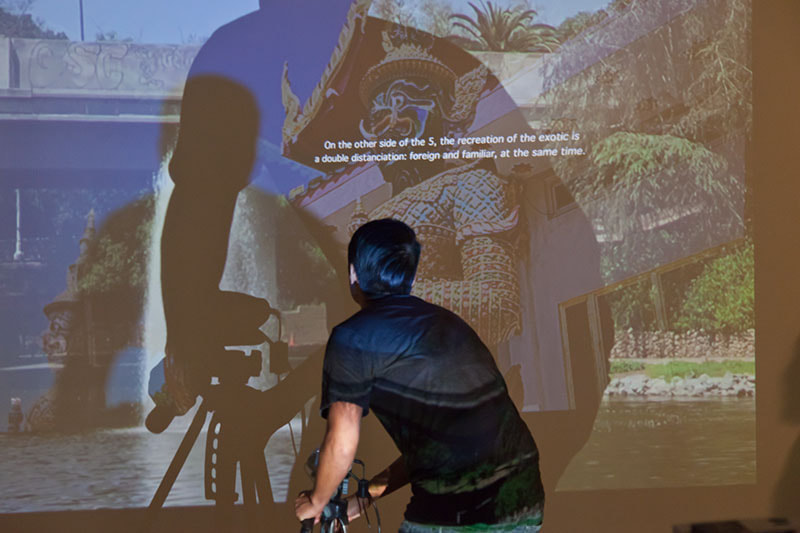 Pic. 1 — 1973, a performance by Prima observing Thai political history of the student revolt in 1973.
Pic. 1 — 1973, a performance by Prima observing Thai political history of the student revolt in 1973.
ปภพ เกิดทรัพย์ (กราฟ) — พรีมา คุณช่วยแนะนำตัวเองสั้นๆ และพูดให้เราฟังได้มั้ยว่าคุณมาสนใจในหัวข้อเกี่ยวกับอนุสาวรีย์ และได้เข้ามาเกี่ยวพันกับประเด็นที่ยุ่งยากนี้ได้ยังไง?
พรีมา ชาลีจันทร์ ศกุนตาภัย (พรีมา) — เราชื่อพรีมา เป็นศิลปินไทยที่ตอนนี้อาศัยอยู่ที่แอลเอ เราคิดว่าคำถามเกี่ยวกับเรื่องอนุสาวรีย์เกิดขึ้นในงานของเราอยู่บ่อยๆ เพราะเราสนใจสถาปัตยกรรมในฐานะเป็นสิ่งขับเคลื่อนอุดมการณ์ สนใจว่าพื้นที่ทางสถาปัตยกรรม ช่วยทำให้อุดมการณ์ปรากฏรูปร่างชัดเจนได้ยังไง และพื้นที่นั้นส่งอิทธิพลต่อร่างกายยังไง เราเดาว่ามันเกิดจากการที่เราโตที่ยุโรป รายล้อมไปด้วยอนุสาวรีย์ และวัฒนธรรมที่เกี่ยวข้องกับมัน เราเลยมีคำถามมากมายต่ออนุสาวรีย์ในวัฒนธรรมตะวันตก แต่พอเราได้ต่อยอดการทำงานของตัวเองมาในสายการแสดง เราถึงเริ่มที่จะสนใจในอนุสาวรีย์ที่ถูกอนุมานความหมายลงไป ซึ่งก็ไม่ใช่แค่อนุสาวรีย์ที่ถูกสร้างโดยรัฐเท่านั้น ยกตัวอย่างเช่น เราพาตัวเองท่องไปในเมืองแอลเอ พร้อมๆ กับคิดถึงแง่มุมอันหลากหลายของประวัติศาสตร์ ไม่ว่ามันจะถูกแปลงเป็นภาพวาดฝาผนังบนกำแพง (mural) ที่ถูกทิ้งไว้โดยประชาชน หรือแม้กระทั่งเรื่องที่คนพูดถึงกันอยู่ตอนนี้อย่างการทำลายโครงสร้างทางด่วน ในฐานะที่เป็นอนุสาวรีย์ของการแบ่งแยกเชื้อชาติ จากการลงไปศึกษาเรื่องเหล่านี้ มันเชื่อมความพยายามของเราเข้ากับประวัติศาสตร์ไทย มันดึงเราเข้าไปสู่ประวัติศาสตร์การจลาจลในปี 2516 (เหตุการณ์ 14 ตุลา 2516) และร่องรอยทางกายภาพที่หลงเหลือเพียงน้อยนิดจากเหตุการณ์นั้นถูกทิ้งไว้ยังไงในประเทศไทย
รูป 1 — 1973, การแสดงโดยพรีมา สำรวจประวัติศาสตร์การเมืองไทย เรื่องการต่อสู้ของนักศึกษาในปี 2516 (14 ตุลา)
Graf — Now, I guess a lot of people (outside the art world) may have recognized you from your recent book จวบจันทร์แจ่มฟ้านภาผ่อง: ศิลปะและศิลปินแห่งรัชสมัยรัชกาลที่ 9 (Chuap Chan Chaem Fa Napha Phong: Art and Artists in the Reign of King Rama IX) published by Fa Diew Kan (Same Sky Books) earlier this year which is now one of its best-selling titles. But, many may not know exactly what your PhD dissertation, titled Revolution versus Counter-Revolution: the People’s Party and the Royalist(s) in Visual Dialogue, is all about. So, perhaps can you start from that, Thanavi? And what is your interest and practice at the moment?
Thanavi Chotpradit (Thanavi) — My name is Thanavi Chotpradit. I’m a lecturer of art history, specializing in modern and contemporary art in Thailand with a specific interest in politics and memory studies. I’m also a member of an editorial collective of a peer-reviewed journal Southeast of Now: Contemporary and Modern Art in Asia. My interest in monuments and the business of remembering and forgetting began with my PhD thesis in 2011. I studied the monuments and memorials built by the People’s Party and how it plays within the ideological battle between royalism and constitutionalism, which is now understood as democracy. My PhD thesis covers the period from 1932 to 1947 and 2010 when the Red Shirts held many of their political activities at the monuments built by the People’s Party.
I also look into contemporary artworks from Thai artists who have been doing what in relation to politics. I think in the current political situation, it is interesting to observe how the practices around monuments and memory include the history of people from different periods, not limited to the People’s Party: Why do people revive them, in what form, and how they appear in the protests? It’s not being revived just to know what happened in the past, they also have something to do with the current political conflict. For example, the People’s Party became something like a forefather for Thai democracy, that’s why the Red Shirts and also people in the current protest always refer to them. Constructions like buildings, monuments, memorials, and works of art from that period are revitalized within the protest.
There is also an emergence of monument online archives that came from people who use their phones to take pictures of the monuments, such as a record of the demolition of the Constitution Defense Monument that was distributed on the internet. So, it’s not easy to make people forget anymore. It’s not like in the past that you might burn down the books, close the libraries, tear down the monuments, and people would forget within five years or ten years. You don’t need to work at the National Archive to create an archive. You can do it on your own, in any forms of reproduction. Whether something that already disappeared like the original People’s Party Plaque, or something that still exists like the Democracy Monument; they have become cookies, pancakes, or keychains. You still need the actual authentic monuments, but there are some other things that can function in making people not to forget. As a Thai citizen, this is not a nice time but an interesting period for me.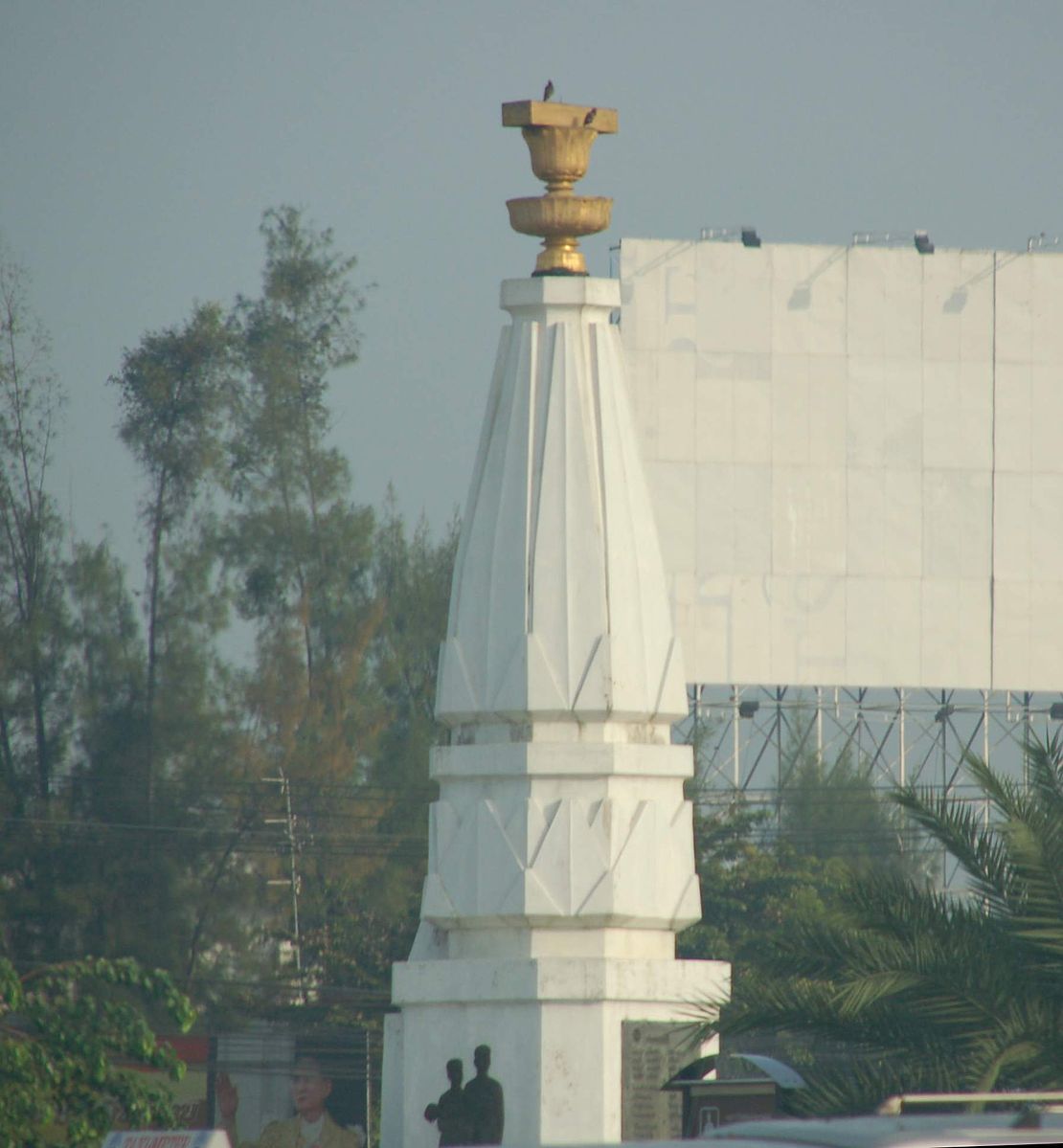
Pic. 2 — Constitution Defense Monument was erected in 1936 to commemorate the newly established constitutional democracy after Prince Boworadet’s failed revolt. It was placed in Bang Khen District’s Lak Si Circle and later removed on 2016. In 2018, the monument was removed without notice or explanation by persons unknown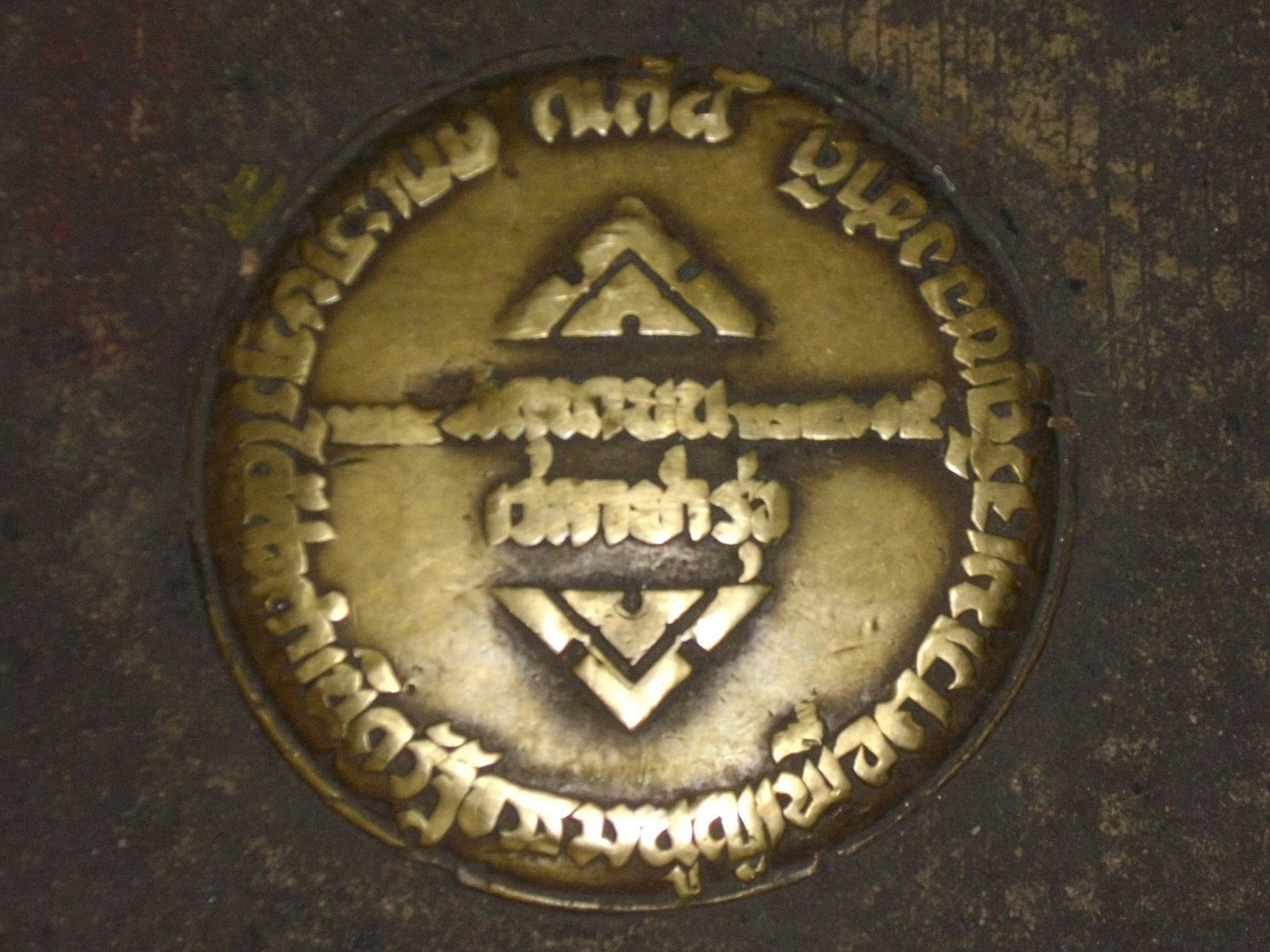
Pic. 3 — In 1936, four-and-a-half years later from the revolution in Thailand, one of the leaders of that uprising and the first post-revolution prime minister Phraya Phahol held a small ceremony, embedding the People’s Party plaque into The Grounds of the Dusit Palace where he had first announced the end of the absolute monarchy. The inscription on it read: “Here on 24 June 1932 at dawn, the People’s Party proclaimed a constitution for the country’s advancement.” 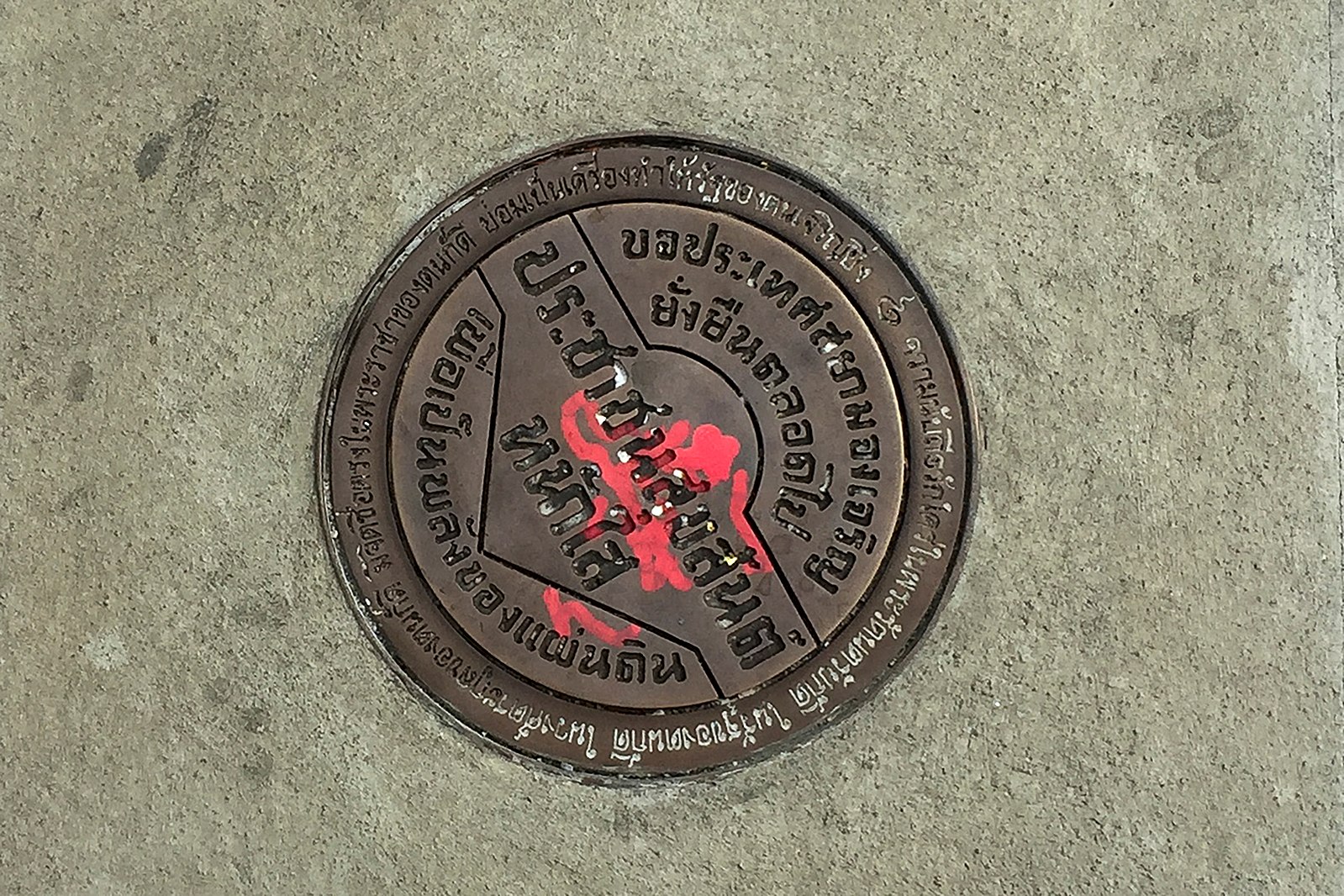
Pic. 4 — In 2017, the plaque was removed by persons unknown and replaced with the new plaque with an inscription: “May the country of Siam prosper forever. To love and respect the Buddhist trinity, one’s own state, one’s own family, and to have a heart faithful to your monarch, will bring prosperity to the country.”
Pic. 5 — 2020 People’s Party Plaque is a new plaque to commemorate the 1932 revolution, made by the pro-democracy protesters. It was installed in the morning of September 20 on the Sanam Luang field during a protest. Part of the inscription on the plaque read: “At the dawn of Sep 20, 2020 here is where the people proclaim that this country belongs to the people,” This 2020 People’s Party Plaque was removed on September 21.
Pic. 6 — Pancake by Tokyo Hot, made into an image of 2020 People’s Party Plaque.
กราฟ — ตอนนี้เราคาดว่ามีหลายคน (นอกวงการศิลปะ) อาจจะจำคุณได้จากหนังสือของคุณที่เพิ่งออกมาไม่นานนี้ จวบจันทร์แจ่มฟ้านภาผ่อง: ศิลปะและศิลปินแห่งรัชสมัยรัชกาลที่ 9 ที่ตีพิมพ์โดยสำนักพิมพ์ฟ้าเดียวกันเมื่อต้นปีที่ผ่านมา ซึ่งตอนนี้กลายเป็นหนึ่งในเล่มที่ขายดีที่สุดของสำนักพิมพ์แล้ว แต่หลายคนอาจจะไม่รู้ว่าจริงๆ แล้วปริญญานิพนธ์ของคุณที่ชื่อว่า Revolution versus Counter-Revolution: the People’s Party and the Royalist(s) in Visual Dialogue นั้นเกี่ยวกับอะไร บางทีคุณอาจจะเริ่มเล่าจากตรงนี้มั้ย ธนาวิ? ความสนใจของคุณและสิ่งที่คุณกำลังศึกษาอยู่ในตอนนี้คืออะไร?
ธนาวิ โชติประดิษฐ (ธนาวิ) — เราชื่อธนาวิ โชติประดิษฐ เป็นอาจารย์อยู่ภาควิชาประวัติศาสตร์ศิลปะ ที่เชี่ยวชาญในเรื่องของศิลปะสมัยใหม่ และร่วมสมัยในประเทศไทย แต่ก็สนใจเป็นพิเศษในเรื่องของการเมืองและการศึกษาเรื่องความทรงจำ เรายังเป็นหนึ่งในกองบรรณาธิการของวารสารวิชาการที่ชื่อ Southeast of Now: Contemporary and Modern Art in Asia ด้วย ความสนใจในเรื่องอนุสาวรีย์ เรื่องของการจดจำและการลืม เริ่มต้นตอนที่เราทำปริญญานิพนธ์ในปี 2554 เราศึกษาอนุสาวรีย์และอนุสรณ์สถานที่สร้างโดยคณะราษฎร และวิธีที่มันถูกใช้ในการต่อสู้ทางอุดมการณ์ระหว่างฝ่ายกษัตริย์นิยม และฝ่ายรัฐธรรมนูญนิยม หรือประชาธิปไตย อย่างที่เราเข้าใจกันในปัจจุบัน ช่วงเวลาที่เราศึกษาเริ่มตั้งแต่ปี 2475 ถึงปี 2490 รวมถึงปี 2553 เมื่อกลุ่มคนเสื้อแดงได้ใช้อนุสาวรีย์ที่สร้างโดยคณะราษฎรในการจัดกิจกรรมทางการเมือง
เรายังศึกษางานศิลปะร่วมสมัยโดยศิลปินไทย ที่ทำงานเกี่ยวข้องกับเรื่องของการเมือง เราคิดว่าสถานการณ์ทางการเมืองในตอนนี้มีความน่าสนใจตรงที่ว่า ปฏิบัติการที่รายรอบอนุสาวรีย์และความทรงจำ ได้นับรวมเอาประวัติศาสตร์ของผู้คนจากหลายยุคสมัย โดยไม่จำกัดอยู่เพียงแค่คณะราษฎรไว้ยังไง ทำไมผู้คนจึงรื้อฟื้นสิ่งเหล่านี้ รื้อฟื้นในรูปแบบไหนบ้าง การรื้อฟื้นนี้ปรากฏตัวออกมายังไงในการชุมนุม? มันไม่ใช่แค่การรื้อฟื้นเพื่อที่จะเรียนรู้ว่าเกิดอะไรขึ้นในอดีต แต่มันเชื่อมโยงกับความขัดแย้งทางการเมืองในปัจจุบันด้วย ยกตัวอย่างเช่น คณะราษฎรที่ได้กลายเป็นบรรพบุรุษของประชาธิปไตยไทยนั้นถูกอ้างถึงในชุมนุมการประท้วงของกลุ่มคนเสื้อแดงและกลุ่มอื่นๆ อยู่เสมอ สิ่งก่อสร้างอย่างอาคาร อนุสาวรีย์ อนุสรณ์สถาน และงานศิลปะในยุคนั้น ได้กลับมามีชีวิตชีวาขึ้นโดยเป็นส่วนหนึ่งของการประท้วง
ยังมีเรื่องของการเกิดขึ้นของอนุสาวรีย์ที่ถูกจัดเก็บไว้บนโลกออนไลน์ ที่เกิดจากใครก็ตามที่ใช้มือถือถ่ายภาพอนุสาวรีย์ต่างๆ ไว้ อย่างบันทึกวิดีโอภาพการรื้อทำลายอนุสาวรีย์พิทักษ์รัฐธรรมนูญที่ถูกแพร่กระจายไปบนอินเทอร์เน็ต มันไม่ง่ายอีกต่อไปที่จะทำให้ผู้คนลืมอะไรง่ายๆ ไม่เหมือนกับในอดีตที่คุณอาจจะเผาหนังสือ ปิดห้องสมุด หรือทำลายอนุสาวรีย์ แล้วผู้คนจะลืมมันภายในห้าปีหรือสิบปี คุณไม่ต้องทำงานที่หอจดหมายเหตุแห่งชาติเพื่อที่จะเก็บบันทึก คุณสามารถทำได้ด้วยตัวคุณเอง ในรูปแบบของการผลิตซ้ำแบบไหนก็ได้ ทำกับสิ่งที่หายไปแล้วก็ได้ อย่างหมุดคณะราษฎรของจริง หรือสิ่งที่ยังคงอยู่อย่างอนุสาวรีย์ประชาธิปไตย พวกมันกลายเป็นคุกกี้ แพนเค้ก พวงกุญแจ คุณอาจจะยังต้องการอนุสาวรีย์อันจริง แต่มันก็มีสิ่งอื่นที่สามารถทำหน้าที่ในการทำให้ผู้คนไม่ลืมได้เหมือนกัน ในฐานะที่เป็นประชากรไทย มันอาจจะไม่ใช่ช่วงเวลาที่ดีนักในตอนนี้ แต่สำหรับเราก็นับว่าเป็นช่วงเวลาที่น่าสนใจ
รูป 2 — อนุสาวรีย์พิทักษ์รัฐธรรมนูญ มีพิธีเปิดอย่างเป็นทางการในปี 2479 โดยรัฐบาลคณะราษฎร เพื่อรำลึกถึงการปราบกบฏบวรเดช ซึ่งเป็นความขัดแย้งระหว่างคณะเจ้ากับคณะราษฎร อนุสาวรีย์แห่งนี้ตั้งอยู่ที่วงเวียนหลักสี่ เขตบางเขน ต่อมาได้มีเคลื่อนย้ายตำแหน่งในปี 2559 และถูกรื้อถอนโดยบุคคลนิรนาม โดยไม่มีการแจ้งล่วงหน้าและไม่มีการอธิบายในปี 2561
รูป 3 — ในปี 2479 สี่ปีครึ่งหลังจากที่มีการปฏิวัติในประเทศไทย หนึ่งในผู้นำกลุ่มปฏิวัติ พระยาพหลพลพยุหเสนา ได้จัดพิธีกรรมเล็กๆ ในการปักหมุดคณะราษฎรลงที่พื้นของลานพระบรมรูปทรงม้า ที่ซึ่งเป็นจุดแรกที่เขาได้ประกาศยุติระบอบการปกครองแบบสมบูรณาญาสิทธิราชย์ บนหมุดมีการจารึกไว้ว่า “ณ ที่นี้ ๒๔ มิถุนายน ๒๔๗๕ เวลาย่ำรุ่ง คณะราษฎรได้ก่อกำเนิดรัฐธรรมนูญเพื่อความเจริญของชาติ” 
รูป 4 — ในปี 2560 หมุดคณะราษฎรได้ถูกเปลี่ยนโดยบุคคลนิรนามพร้อมกับคำจารึกใหม่บนหมุด “ขอประเทศสยามจงเจริญยั่งยืนตลอดไป ประชาชนสุขสันต์ หน้าใส เพื่อเป็นพลังของแผ่นดิน ความนับถือรักใคร่ในพระรัตนตรัยก็ดี ในรัฐของตนก็ดี ในวงศ์ตระกูลของตนก็ดี มีจิตซื่อตรงในพระราชาของตนก็ดี ย่อมเป็นเครื่องทำให้รัฐของตนเจริญยิ่ง”
รูป 5 — หมุดคณะราษฎร 2563 เป็นหมุดใหม่โดยกลุ่มผู้ประท้วงเรียกร้องประชาธิปไตย จัดทำขึ้นเพื่อระลึกถึงการปฏิวัติ 2475 หมุดนี้ถูกติดตั้งที่สนามหลวงในวันที่ 20 กันยายน ระหว่างที่มีการประท้วง คำจารึกบางส่วนบนหมุด: “20 กันยายน 2563 เวลาย่ำรุ่ง ณ ที่นี้ ผองราษฎรได้แสดงเจตนารมณ์ ประเทศนี้เป็นของราษฎร…” หมุดคณะราษฎรนี้ได้ถูกรื้อถอนออกไปในวันที่ 21 กันยายน 
รูป 6 — แพนเค้กจากร้านโตเกียวฮอท ทำเป็นรูปหมุดคณะราษฎร 2563
Graf — Since the word that has brought us together in this conversation is ‘monument’, I would like to begin with this simple question: What is a monument? And from your perspective, to what extent can we call something a monument? Does its physicality matter or that’s equally fine for it being transformed into digital data or, to cite Hito Steyerl’s term, ‘a poor image’?
Prima — I really like the point you brought up, Thanavi, about how in the absence of authentic monuments, its memory of potency may be actually multiplied by digital reproductions and transformations of the object. My loose definition of monument these days is more a device that helps memory. Throughout history, a certain type of collective memory is tied to nationalism. It is used to promote the value of the state and whatever the state wants people to feel connected to. The word state is also kind of a loose term that is not tied to a specific place or culture. To the more specific case of whether it is necessary that monuments are material anymore, I guess that has been mostly how I relate to monuments in Thailand. A lot of the People’s Party monuments and architectures have already been demolished. So, I feel like the process of learning has been through looking for traces of things that no longer exist. I am starting to wonder if it’s specific to the history of Thailand because the politics have been so repressed, especially concerning the People’s Party legacy throughout the physical landscape of Thailand itself. And then on top of that, since I’m a person who relies heavily on these digital images and reproductions, I do think that it is exciting that they have become a vehicle for these memories because we might be able to infer that they would never really die.
Pic. 7 — Screenshot from Chloropsis Aurifrons Pridii, a lecture performance by Prima.
กราฟ — เนื่องจากคำที่พาเรามาพูดคุยกันในวันนี้คือคำว่า ‘อนุสาวรีย์’ เราอยากที่จะเริ่มด้วยคำถามง่ายๆ ว่าอนุสาวรีย์คืออะไร? ขอบเขตของการเรียกบางสิ่งว่าเป็นอนุสาวรีย์คืออะไรในมุมมองของพวกคุณ? ความเป็นกายภาพนั้นจำเป็นมั้ย หรือก็เป็นไปได้พอๆ กันที่มันจะถูกแปลงไปอยู่ในรูปแบบของข้อมูลดิจิทัล หรือในรูปแบบของ ‘ภาพกาก’ (a poor image) อย่างที่ฮิโตะ ชไตเยิร์ล นิยามไว้?
พรีมา — เราชอบประเด็นที่ธนาวิยกมาพูด เกี่ยวกับว่า การหายไปของอนุสาวรีย์ของจริง และการหายไปของความทรงจำของอำนาจนั้น แท้จริงแล้วเพิ่มเป็นทวีคูณด้วยการผลิตซ้ำแบบดิจิทัล และการเปลี่ยนรูปแบบของสิ่งๆ นั้น นิยามแบบหลวมๆ ที่เรามีต่ออนุสาวรีย์ทุกวันนี้ คือเรามองมันเป็นเครื่องมือช่วยจำ ตลอดเวลาที่ผ่านมาในประวัติศาสตร์ การสร้างความทรงจำร่วมประเภทนึงถูกยึดโยงอยู่กับลัทธิชาตินิยม มันถูกใช้ในการส่งเสริมคุณค่าของรัฐ และส่งเสริมอะไรก็ตามที่รัฐอยากให้ประชาชนรู้สึกเชื่อมโยงถึง คำว่ารัฐในที่นี้คือนิยามแบบหลวมๆ ที่มันไม่ได้ยึดโยงอยู่กับสถานที่หรือวัฒนธรรมใดเป็นพิเศษ ในกรณีที่พิเศษกว่านั้นว่าจำเป็นมั้ยที่อนุสาวรีย์ยังคงต้องมีกายภาพ เราคิดว่านี่คือสิ่งที่เรารู้สึกกับอนุสาวรีย์ในประเทศไทยเป็นส่วนมาก อนุสาวรีย์และสถาปัตยกรรมหลายแห่งของคณะราษฎรถูกทำลายไปแล้ว ดังนั้นเรารู้สึกว่ากระบวนการเรียนรู้กลับเกิดขึ้นผ่านการดูร่องรอยที่ไม่หลงเหลืออยู่แล้ว เราเริ่มสงสัยว่ามันเป็นเฉพาะกับประวัติศาสตร์ไทยรึเปล่า เพราะการเมืองมันค่อนข้างถูกควบคุม โดยเฉพาะสิ่งที่เกี่ยวข้องกับตำนานของคณะราษฎร อย่างภูมิทัศน์ทางกายภาพในประเทศไทยเอง ยิ่งไปกว่านั้น เราเองก็เป็นคนนึงที่อ้างอิงภาพดิจิทัลและการผลิตซ้ำหนักมาก เราคิดว่ามันน่าตื่นเต้นที่มันกลายเป็นตัวขับเคลื่อนความทรงจำเหล่านี้ เพราะเราอาจจะสามารถอนุมานได้ว่าคณะราษฎรไม่มีวันตาย
รูป 7 — สกรีนชอตจากงานวิดีโอ Chloropsis Aurifrons Pridii งานแสดงบรรยายโดยพรีมา
Graf — What about you?
Thanavi — I think we can start with the broader terms like ‘memory’ and ‘commemoration’. Monument is one of the memory devices. It’s a construction built to commemorate something, some incidents, some people, or something that is important, or something that the nation thinks it is important for anyone to know, to remember, to hand on to other generations. The conventional way of making a monument is to build something very visible, a landmark of a city, or a spot where something happened and you want to mark the place that things happen there. Therefore, the monument is one of the many ways that makes people remember something.
Other than monuments, there’s also a memorial. We might not talk about the People’s Party Plaque as a monument because it’s flat on the ground, not so visible, but it’s an object that commemorates something. You can build a hospital and dedicate it to a person, whatever she/he did in the past, and use the name of that person as the name of the hospital, or you put the bench in the park with the name of someone that you dedicate it to. These objects basically function as a commemorative device of the society but there are other things too. History for example, textbooks also make people not to forget something. I think for monuments, it’s very visible and materialistic, but for now, the definition of monument expands into something that is probably quite intangible.
I also have another work that has to do with memory. It’s my research that I work with Kornkrit Jianpinidnan that was published into a photobook titled Prism of Photography: Dispersion of Knowledge and Memories of the 6th October Massacre. It’s about the memory of the 6th October Massacre, which happened in the seventies. There is a small monument of the 6th October Massacre at Thammasat University. You have to go there to see it. But in other forms, something else other than monuments, you probably don’t have to travel to the place to know about the story. To me, a monument is still important and relevant but it’s not the only way to remember.
Pic. 8 — Prism of Photography: Dispersion of Knowledge and Memories of the 6th October Massacre by Kornkrit and Thanavi.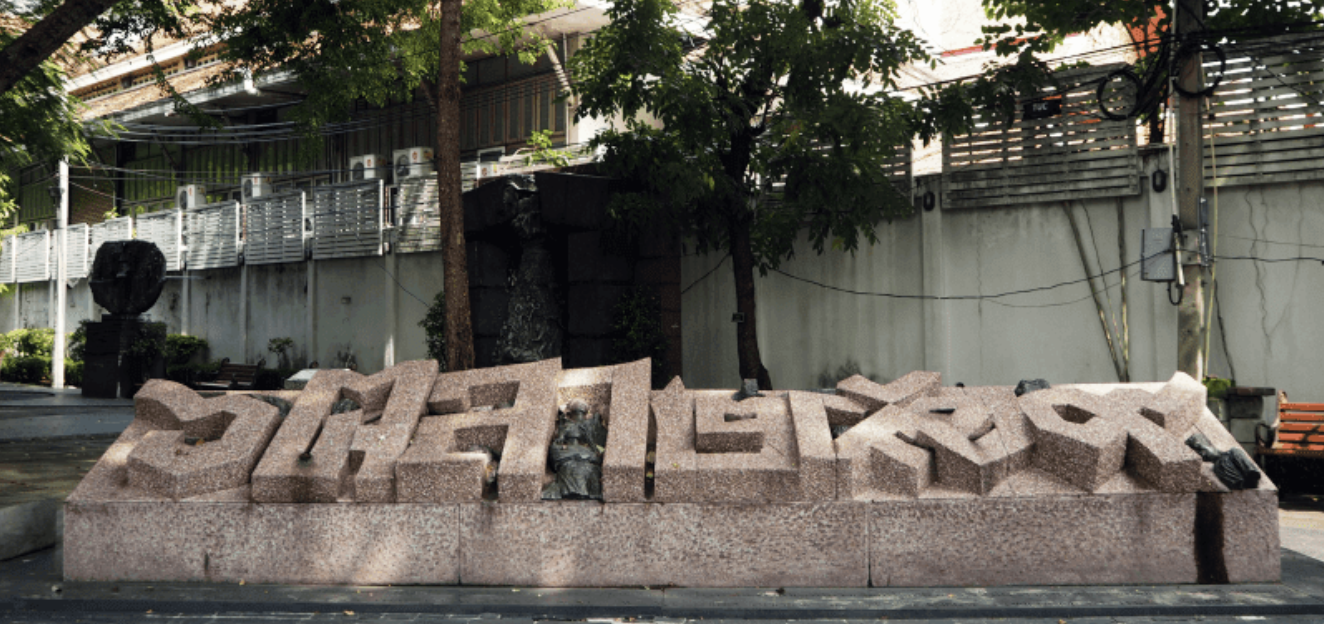
Pic. 9 — A monument of the 6th October Massacre at Thammasat University.
กราฟ — แล้วสำหรับคุณล่ะ?
ธนาวิ — คิดว่าเราสามารถเริ่มจากนิยามกว้างๆ อย่างคำว่า ‘ความทรงจำ’ และ ‘การรำลึก’ อนุสาวรีย์เป็นหนึ่งในเครื่องมือช่วยจำ โครงสร้างของมันถูกสร้างขึ้นเพื่อรำลึกถึงบางสิ่ง เหตุการณ์บางอย่าง คนบางคน อะไรที่มีความสำคัญ หรืออะไรที่ชาติคิดว่าสำคัญสำหรับทุกคนที่ต้องเรียนรู้ จดจำ ส่งต่อสู่รุ่นต่อไป วิธีการโดยดั้งเดิมในการสร้างอนุสาวรีย์คือการสร้างอะไรที่เห็นเด่นชัด เป็นจุดสังเกตของเมือง หรืออยู่ในจุดที่มีอะไรเคยเกิดขึ้นมาก่อน ดังนั้นอนุสาวรีย์คือหนึ่งในหนทางที่จะทำให้ผู้คนจดจำอะไรบางอย่าง
นอกเหนือจากอนุสาวรีย์แล้ว ก็ยังมีอนุสรณ์สถาน เราอาจพูดไม่ได้ว่าหมุดคณะราษฎร เป็นอนุสาวรีย์เพราะมันแบนราบอยู่กับพื้น ไม่ได้เห็นเด่นชัด แต่มันก็เป็นสิ่งของที่เอาไว้รำลึกถึงบางอย่าง คุณสามารถสร้างโรงพยาบาล อุทิศมันให้กับคนผู้ซึ่งทำประโยชน์อะไรก็ตามในอดีต และใช้ชื่อของคนคนนั้นเป็นชื่อของโรงพยาบาล หรือคุณแค่เอาม้านั่งที่มีชื่อของคนที่คุณอุทิศให้ ไปตั้งในสวนสาธารณะ วัตถุเหล่านี้ โดยพื้นฐานแล้วทำงานเป็นเครื่องมือในการรำลึกถึงของสังคม แต่ก็มีสิ่งอื่นๆ ด้วย อย่างประวัติศาสตร์เป็นต้น ตำรา ก็เป็นสิ่งที่ทำให้ผู้คนไม่ลืมบางอย่าง เราคิดว่าสำหรับอนุสาวรีย์โดยแท้จริง แล้วมันต้องเห็นเด่นชัด และเป็นรูปเป็นร่าง แต่ในตอนนี้ความหมายของมันได้ถูกขยายออก ไปสู่อะไรบางอย่างที่ดูค่อนข้างจะจับต้องไม่ได้
มีอีกงานนึงที่เราทำเกี่ยวกับเรื่องความทรงจำ มันเป็นงานวิจัยที่เราทำงานร่วมกับ กรกฤช เจียรพินิจนันท์ ที่ได้ตีพิมพ์ออกมาเป็นโฟโต้บุ๊คในชื่อ ปริซึมของภาพถ่าย: การแตกตัวขององค์ความรู้และความทรงจำว่าด้วยเหตุการณ์ 6 ตุลา เกี่ยวกับความทรงจำของการสังหารหมู่ในวันที่ 6 ตุลา ที่เกิดขึ้นในช่วงยุคเจ็ดศูนย์ มันมีอนุสาวรีย์เล็กๆ ของเหตุการณ์ 6 ตุลานี้อยู่ที่มหาวิทยาลัยธรรมศาสตร์ คุณต้องเดินทางไปดูเพื่อที่จะเห็นมัน แต่ในอีกรูปแบบนึง บางสิ่งที่ไม่ใช่อนุสาวรีย์ คุณอาจจะไม่ต้องเดินทางไป ณ สถานที่นั้นเพื่อที่จะเรียนรู้เรื่องของมัน สำหรับเรา อนุสาวรีย์ยังคงสำคัญและมีความเกี่ยวข้อง แต่มันก็ไม่ใช่หนทางเดียวในการที่จะจำ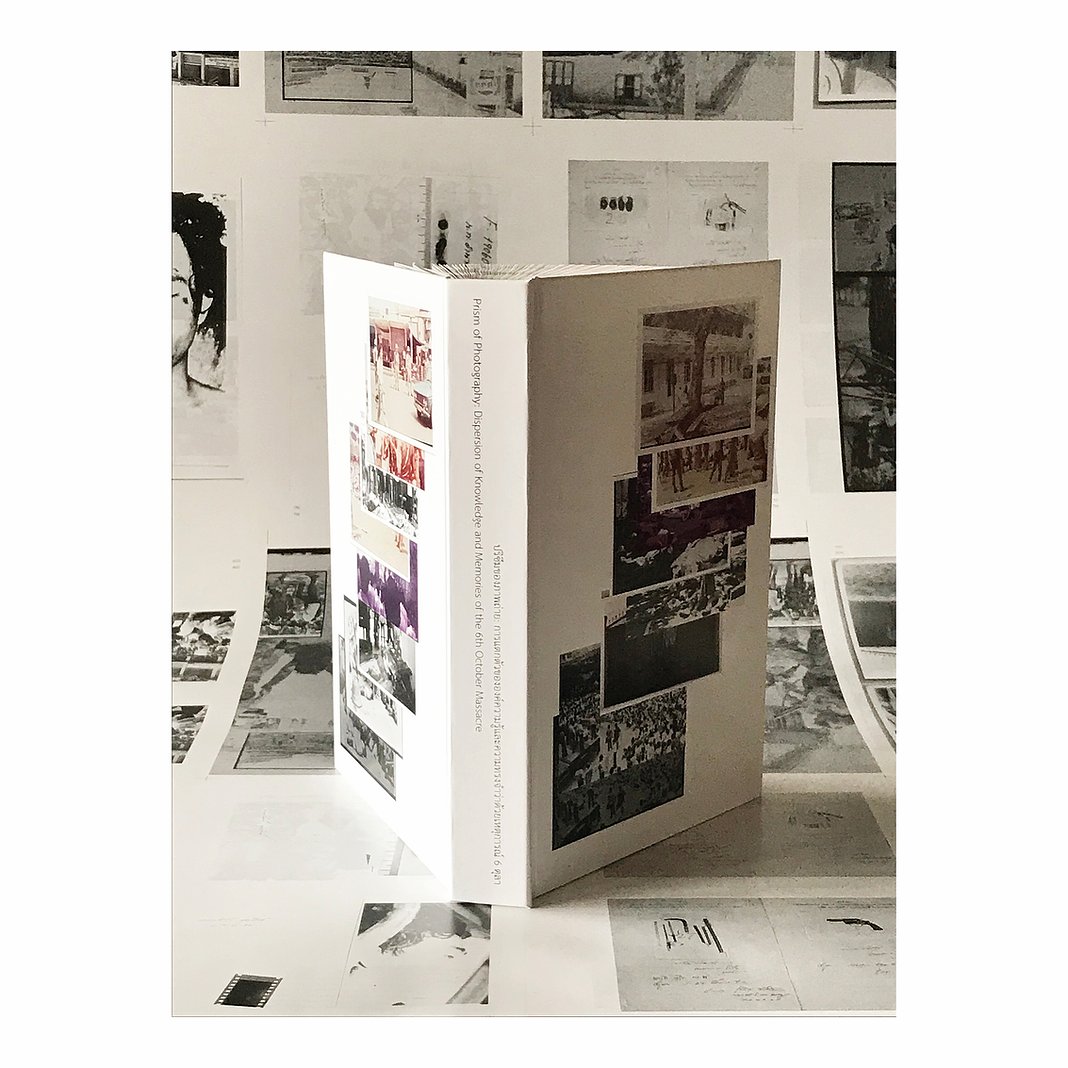
รูป 8 — ปริซึมของภาพถ่าย: การแตกตัวขององค์ความรู้และความทรงจำว่าด้วยเหตุการณ์ 6 ตุลา โดย กรกฤช และ ธนาวิ
รูป 9 — ประติมานุสรณ์ 6 ตุลา 2519 รำลึกการสังหารหมู่ 6 ตุลา ที่มหาวิทยาลัยธรรมศาสตร์
Graf — At present, we’ve seen an immense proliferation of political memes. Take the second People’s Party Plaque installed on the ground of Sanam Laung on September 20th as an example. It was there for only one day and was removed. And right now it becomes a file for image reproduction, a 3D printing or a LINE sticker. What do you think about this idea of how the internet came into being another powerful, yet very creative and contemporary, platform for demonstration as well as commemoration in this 21st century?
Thanavi — I think it’s very fun. I have been waiting everyday for what’s going on, what comes next, what’s new on the internet today. I think maybe we can use the term ‘commemoration’ to cover everything, all these political memes that are actually on and off, or it’s online and it’s on site. There is a connection between online and offline and the amount of two practices are very high. I also see it as a resistance to the state because they have the power to demolish or to remove the monument as they have been doing for so many years now. Like in the case of the disappeared People’s Party Plaque from the The Grounds of the Dusit Palace that some people have questioned who would be responsible for it. At the same time, some people have tried to make a reproduction or a meme of those disappeared commemorated objects to make people still know about them, or even know more about them. Some people may have never heard about the People’s Party Plaque until it was removed from its place. I think it’s a good thing and it’s the way that ordinary people could resist the state’s attempt to remove these commemorative objects. It’s fun and can be very creative. It is serious but can be fun. Humor is a very important element in the protests. You have to make it fun and satirical, and this could be one of the ways to make it go viral. Mocking the monument for some people is still unacceptable, but some people start to make it speakable. That’s a good sign.
กราฟ — ณ ตอนนี้ เราเห็นการแพร่กระจายอย่างกว้างขวางของมีมการเมือง อย่างเรื่องของหมุดคณะราษฎรอันที่สอง ที่ล่าสุดถูกติดตั้งบนพื้นที่ของสนามหลวงเมื่อวันที่ 20 กันยายนที่ผ่านมา ซึ่งก็ถูกติดอยู่ได้เพียงแค่วันเดียวก่อนที่จะถูกรื้อถอน และตอนนี้มันได้กลายเป็นไฟล์ภาพเพื่อการผลิตซ้ำ เป็นภาพพิมพ์สามมิติ เป็นไลน์สติ๊กเกอร์ คุณมีความเห็นยังไงกับเรื่องนี้ที่ว่า อินเทอร์เน็ต ได้กลายเป็นอีกพลังที่ทั้งสร้างสรรค์ ร่วมสมัย เป็นพื้นที่ของการแสดงออก และสร้างความทรงจำในศตวรรษที่ 21 นี้?
ธนาวิ — เราคิดว่ามันสนุกมาก รอดูทุกวันว่าจะมีอะไรเกิดขึ้น จะมีอะไรเป็นสิ่งต่อไป อะไรที่เป็นเรื่องใหม่บนอินเทอร์เน็ตตอนนี้ เราคิดว่าบางทีเราสามารถที่จะใช้คำว่า ‘การรำลึก’ เพื่อที่จะครอบคลุมทุกอย่าง ทั้งมีมการเมืองที่เกิดขึ้นและดับไป หรือการที่มันอยู่บนโลกออนไลน์ และในพื้นที่จริง มันมีความสัมพันธ์ระหว่างโลกออนไลน์กับโลกออฟไลน์อยู่ และจำนวนของวิธีการทั้งสองต่างก็สูงมาก เรามองว่ามันเป็นการต่อต้านรัฐในอีกแง่นึงด้วย เพราะว่ารัฐมีอำนาจในการทำลายหรือเคลื่อนย้ายอนุสาวรีย์อย่างที่เราเห็นกันมาอยู่ตลอดหลายปี อย่างในกรณีของการหายไปของหมุดคณะราษฎรจากลานพระราชวังดุสิต (ลานพระบรมรูปทรงม้า) ที่หลายคนสงสัยว่าใครจะต้องรับผิดชอบกับเรื่องนี้ ในขณะเดียวกันคนบางกลุ่มก็พยายามที่จะสร้างการผลิตซ้ำ หรือสร้างมีม ให้กับวัตถุเพื่อการรำลึกที่สูญหาย เพื่อให้ผู้คนได้เรียนรู้เกี่ยวกับมัน หรือรู้มากขึ้นเกี่ยวกับมัน บางคนอาจจะไม่เคยได้ยินเรื่องหมุดคณะราษฎรมาก่อน จนกระทั่งมันหายไปจากที่ที่ควรอยู่ เราคิดว่ามันเป็นเรื่องดี และเป็นวิธีที่คนทั่วไปสามารถต่อต้านความพยายามของรัฐในการถอดถอนวัตถุเพื่อการรำลึก มันทั้งสนุกและสร้างสรรค์ มีความจริงจังแต่ก็สนุก อารมณ์ขันเป็นปัจจัยสำคัญในการจัดในการประท้วง คุณต้องทำให้มันสนุกและเสียดสี และมันอาจจะเป็นอีกหนึ่งช่องทางในการเผยแพร่ไปอย่างรวดเร็ว การล้อเลียนอนุสาวรีย์สำหรับบางคนแล้วก็ยังเป็นเรื่องที่รับไม่ได้ แต่บางคนก็เริ่มที่จะทำให้มันแตะต้องได้แล้ว นับว่าเป็นสัญญาณที่ดี
Graf — What do you think about this phenomenon, Prima? Any similar situations that are happening at the moment in the States that you would like to share?
Prima — The United States isn’t’ that creative about how to save their monuments compared to people in Thailand. We are in the reverse process of taking down monuments that are related to the history of racism and white supremacy that are present in a lot of places. In LA for instance, in front of the Union Station which is the main train station, there was a statue of Junípero Serra who was the Spanish missionary basically in charge of converting the indegenous people in the area. So, there was an indegenous ceremony that happened around it and ended with the people bringing down the monument with ropes. It reminds me a lot of the early footage of the moment after the fall of the Berlin Wall when people brought down the statues of Lenin and Stalin around Russia. But, going back to the monument being saved by the internet, it makes me think of the idea of living memory and I feel the traditional sense of monuments has been so guarded by the state and removed from the people. Most of the time I feel like monuments are treated that way: they are on pedestals, they are much higher than people. You are not allowed to touch them or climb on them. Only at times of protest do people gravitate to and bring those symbols down to a more profane space and I think that the proliferation of memes seem to be invigorating those monuments with new meaning and connecting the past with the present. So that there’s no longer a difference between the two. 
Pic. 10 — The statue of Junípero Serra at the Serra Father Park, Union Station, LA, CA, before being demolished. He was a Roman Catholic Spanish priest and friar of the Franciscan Order. Serra’s reputation and missionary work during the Spanish occupation have been condemned by critics, who point to mandatory conversions to Catholicism, followed by abuse of the Native American converts.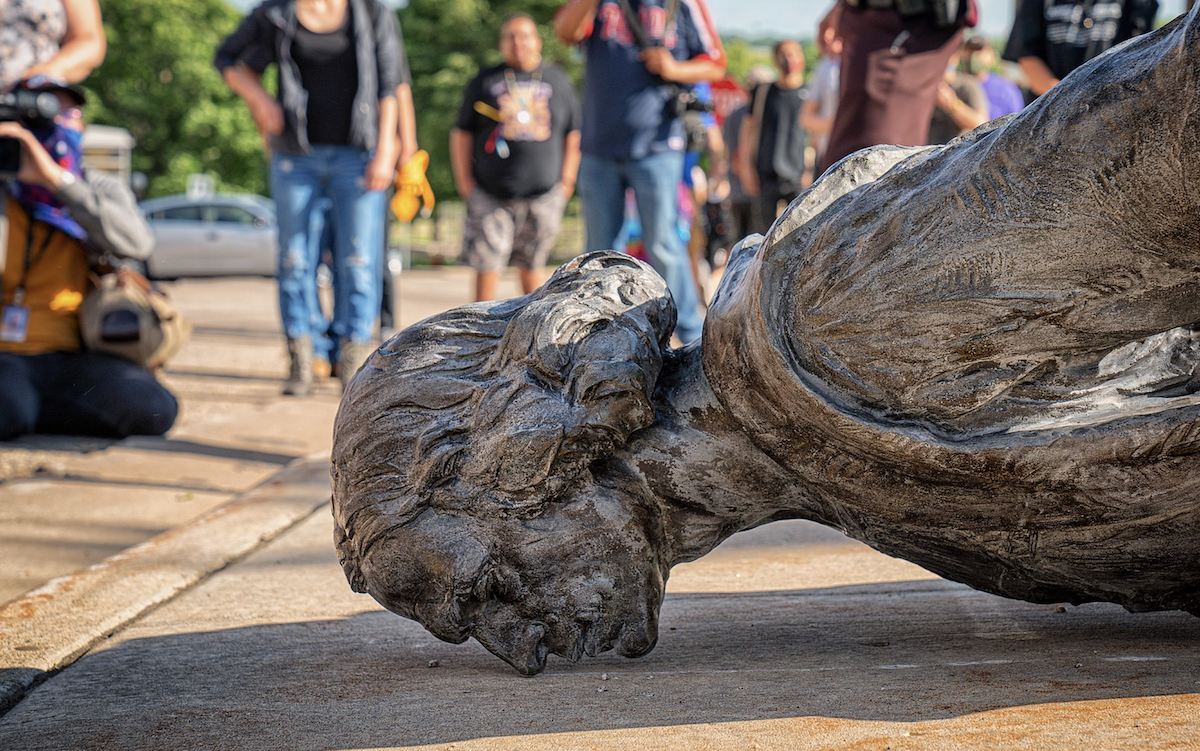
Pic. 11 — The fallen Christopher Columbus statue outside the Minnesota State Capitol after a group led by American Indian Movement members tore it down in St. Paul, Minnesota, on June 10, 2020. (See Toppling Monument, a Visual History.)
กราฟ — แล้วคุณคิดยังไงกับปรากฏการณ์นี้พรีมา? มีเหตุการณ์ที่คล้ายๆ กันนี้ที่กำลังเกิดขึ้นที่สหรัฐฯ ที่คุณอยากจะเล่าให้ฟังมั้ย?
พรีมา — รัฐที่นี่ไม่ได้มีวิธีที่สร้างสรรค์เท่าไหร่ในความพยายามที่จะรักษาอนุสาวรีย์เอาไว้ เมื่อเทียบกับฝั่งประชาชนที่ไทย ที่สหรัฐ เราอยู่ในกระบวนการที่กลับกันในการรื้อทำลายอนุสาวรีย์ที่เกี่ยวข้องกับประวัติศาสตร์ของการเหยียดเชื้อชาติ และความสูงส่งของคนขาว ที่ปรากฏอยู่ในหลากหลายพื้นที่ อย่างในแอลเอ ที่หน้าสถานีรถไฟหลักของเมืองที่ชื่อ Union Station นั้นมีรูปปั้นของจูนิเปอร์โร เซอร์รา นักสอนศาสนาชาวสเปน ที่ได้รับมอบหมายในการทำให้ชนพื้นเมือง (indegenous) ในพื้นที่เปลี่ยนศาสนา มันเลยมีพิธีกรรมของชนพื้นเมืองเกิดขึ้นในบริเวณนั้น ที่สุดท้ายลงเอยด้วยการดึงเอารูปอนุสาวรีย์นั้นลงมาด้วยเชือก มันทำให้เรานึกถึงภาพฟุตเทจในยุคแรกๆ ของผู้คนที่ดึงเอารูปปั้นของ เลนิน กับ สตาลิน ลง ในช่วงหลังจากการล่มสลายของกำแพงเบอร์ลิน กลับมาที่เรื่องที่อนุสาวรีย์ถูกรักษาไว้โดยอินเทอร์เน็ต มันทำให้เรานึกถึงแนวคิดเรื่องความทรงจำที่มีชีวิต และเรารู้สึกว่าความเข้าใจดั้งเดิมของอนุสาวรีย์ถูกพิทักษ์ไว้โดยรัฐและถูกทำให้ออกห่างจากประชาชน โดยส่วนใหญ่แล้ว เรารู้สึกว่าอนุสาวรีย์จะถูกจัดการไว้แบบที่ให้อยู่บนทางเท้า และสูงส่งกว่าประชาชน คุณไม่มีสิทธิที่จะเอื้อมไปแตะมันหรือปีนมัน มีเพียงตอนประท้วงเท่านั้นที่ผู้คนได้ถ่วงมันและดึงสัญลักษณ์เหล่านั้นสู่พื้นที่ที่ถูกลดทอนความศักดิ์สิทธ์ิ เราคิดว่าการแพร่กระจายของมีมดูเหมือนจะช่วยเสริมกำลังใหักับอนุสาวรีย์ด้วยความหมายใหม่ๆ และเชื่อมเอาอดีตกับปัจจุบันเข้าด้วยกัน มันเลยไม่มีความแตกต่างระหว่างสองสิ่ง (อนุสาวรีย์ในโลกจริง และอนุสาวรีย์ในโลกอินเทอร์เน็ต) อีกต่อไป 
รูป 10 — รูปปั้นของจูนิเปอร์โร เซอร์รา ที่สวน Serra Father Park บริเวณ Union Station ในแอลเอ แคลิฟอร์เนีย ก่อนจะถูกรื้อทำลาย เขาเป็นนักบวชชาวสเปนนิกายโรมันคาธอลิกและเป็นนักบวชของคณะฟรานซิสกัน ชื่อเสียงของเซอร์รา และงานเผยแพร่ศาสนาของเขาในยุคการล่าอาณานิคมของสเปน ถูกประณามโดยนักวิจารณ์ ว่าการบังคับให้เปลี่ยนศาสนาเป็นคาธอลิก เป็นการล่วงละเมิดกับชาวพื้นเมืองของอเมริกา
รูป 11 — รูปปั้นของคริสโตเฟอร์ โคลัมบัส ล้มลงที่ด้านนอกอาคารหอประชุมนิติบัญญัติมลรัฐมินนิโซตา หลังจากถูกกลุ่มนักเคลื่อนไหวที่นำโดยชาวอเมริกันอินเดียนทำลายลง ที่รัฐเซนต์พอล มินนิโซตา ในวันที่ 10 มิถุนายน 2563 (ชม Toppling Monument, a Visual History)
Thanavi — I want to add something. I think the situation in Thailand is opposite to the rest of the world. Here, it’s the state that tries to tear the monuments down but people want to protect them. Anywhere else, it is the people who ask for the demolition of the statues, whether because the person was racist, he had too many slaves in his house, or he was a representation of the former dictator ideology. The force from the people that wanted to remove was high. Here in Thailand, the state thinks the symbols of non-royalism democracy should be removed because the current government is pro-royalist. People here have tried to protect the symbols of non-royalism democracy because it is an ideology that they want to protect and continue.
One more thing is about how people treat the monument as sacred. I think you don’t have to worship the monument or the person who became the monument or the statue. For example Aum Neko, a student activist who is now living in exile in France. She climbed up the statue of Pridi Banomyong, one of the leading members of the People’s Party, located at Thammasat University. It was a very controversial action. The question is can we respect people and at the same time, not worship them like god? For now, the reproduction of monuments and memorials in a funny way on the internet is a kind of similar action to me.
Pic. 12 — Pridi Banomyong Memorial Hall at Thammasat University.
BL — I agree. To worship someone like god forbids us to criticize which indirectly repress our opinion thoroughly.
ธนาวิ — เราอยากจะเสริมอะไรบางอย่าง เราคิดว่าสถานการณ์ในประเทศไทยตอนนี้มันตรงกันข้ามกับที่อื่นๆ ในโลก สำหรับที่นี่เป็นรัฐเองที่พยายามจะเอาอนุสาวรีย์ลง แต่ประชาชนอยากจะเก็บรักษามันไว้ ในที่อื่นๆ ประชาชนคือคนที่เรียกร้องให้เกิดการทำลายรูปปั้น ไม่ว่าจะเป็นเพราะเป็นรูปปั้นของคนที่เหยียดเชื้อชาติ มีทาสบริวารมากมายในบ้าน หรือเป็นตัวแทนของอุดมการณ์แบบเผด็จการ แรงขับเคลื่อนจากประชาชนที่ต้องการให้มีการย้ายอนุสาวรีย์นี้มีสูงมาก ในประเทศไทยรัฐคิดว่าสัญลักษณ์ของประชาธิปไตยที่ไม่ใช่กษัตริย์นิยมควรถูกกำจัด เพราะรัฐบาลปัจจุบันเป็นพวกกษัตริย์นิยม ผู้คนได้พยายามที่จะปกป้องสัญลักษณ์ของประชาธิปไตยที่ไม่ใช่กษัตริย์นิยม เพราะมันเป็นอุดมการณ์ที่พวกเขาต้องการปกป้องรักษาและอยากให้มันดำเนินต่อไป
อีกอย่างที่อยากจะเสริมเกี่ยวกับวิธีการที่ผู้คนเคารพบูชาอนุสาวรีย์ เราคิดว่าคุณไม่ต้องบูชาอนุสาวรีย์หรือบุคคลที่กลายเป็นอนุสาวรีย์หรือรูปปั้น ยกตัวอย่างเช่นในกรณีของอั้ม เนโกะ นักศึกษานักเคลื่อนไหวทางการเมือง ที่ตอนนี้ลี้ภัยอยู่ประเทศฝรั่งเศส เธอปีนขึ้นไปบนรูปปั้นของปรีดี พนมยงค์ หนึ่งในผู้นำกลุ่มคณะราษฎร ที่ตั้งอยู่ที่มหาวิทยาลัยธรรมศาสตร์ มันเป็นการกระทำที่เป็นที่ถกเถียงกันอย่างกว้างขวาง คำถามคือพวกเราสามารถที่จะเคารพคนคนนึงไปพร้อมๆ กับที่ไม่ต้องบูชาเขาเหมือนเป็นพระเจ้าได้มั้ย? ในตอนนี้การผลิตซ้ำ ล้อเลียนอนุสาวรีย์และอนุสรณ์สถานบนอินเทอร์เน็ต ก็เป็นการกระทำที่คล้ายๆ กันกับกรณีของอั้ม เนโกะ
รูป 12 — ห้องอนุสรณ์สถานปรีดี พนมยงค์ ที่มหาวิทยาลัยธรรมศาสตร์
BL — เราเห็นด้วย การบูชาใครก็ตามเป็นพระเจ้าไม่เปิดโอกาสให้เกิดการวิพากษ์วิจารณ์ ซึ่งเป็นสิ่งที่กดทับความคิดเห็นของเราโดยอ้อมมาตลอด
Graf — I think the situation in Thailand is weird. I mean, it really shows that the state doesn’t grant us the right to do such a thing and that’s absurd. Talking about worship, do you think this act of worshiping the statue or monument is something commonly found in culture of the eastern world or Thailand specifically? Do people in the States have to pay respect to some monuments?
Prima — I think it’s definitely only worshipped by the people in power or the people who can find direct use of these monuments for their ideology or derive their ideology from this lineage. I think even more than in Thailand, there’s a bigger cult of worshiping monuments here because history is so scarce in the US. People are grappling for a history to claim, especially the white nationalists because they don’t really have anything to claim. This land is not theirs. They still cannot come to an understanding of that. I think it’s interesting that in the US context there is veneration for that the early foundation of the Republic and the monuments also appear as something very classical, as in representational and belonging to the same canon of European statues of men on horses but there’s also a lot of banalization of memorials.
To bring back to my interest in freeways, I recently realized that sections of freeways in LA and assuming in most US cities, are made into memorials dedicated to different people but most of them are highway officers or LAPD (LA Police Department) police chiefs. I feel like they were telling of who gets privileged in these spaces and obviously it’s seldom people with minoritarian identities. As early as the 1920s, in LA freeway projects have been used as physical barriers to segregate Black and immigrant communities from white communities. If you look at the map of LA, you would see clusters of freeways crossing the poorest neighborhoods, like the Route 110 through South Central, which is majoritarily Black; or the East LA Interstate Interchange cutting up Hispanic neighborhoods of Boyle Heights and East LA. There are no freeways crossing Beverly Hills and Santa Monica. Aside from being physical blockades, freeways bring more pollution to the air quality of these neighborhoods and are sources of noise pollution as well. Since their inception, freeways have been constructed in the interest of those in power against the dispossessed.
Pic. 13 — The East Los Angeles Interchange complex in Boyle Heights, east of Downtown Los Angeles, California, is the busiest freeway interchange in the world.
กราฟ — เราคิดว่าสถานการณ์ในประเทศไทยมันแปลก เราหมายถึงว่ามันแสดงให้เห็นว่ารัฐไม่อนุญาตให้เรามีสิทธิในการทำอะไรเลย ซึ่งมันประหลาด พูดถึงเรื่องของการสักการะบูชา คุณคิดว่าการบูชารูปปั้นหรืออนุสาวรีย์โดยทั่วไปแล้วพบได้ในวัฒนธรรมของฝั่งตะวันออก หรือประเทศไทยโดยเฉพาะรึเปล่า? ผู้คนในสหรัฐต้องให้ความเคารพกับอนุสาวรีย์บางแห่งมั้ย?
พรีมา — เราคิดว่ามันถูกบูชาโดยคนที่มีอำนาจ หรือไม่ก็คนที่สามารถใช้งานมันได้โดยตรงจากอนุสาวรีย์เพื่อส่งเสริมอุดมการณ์ของพวกเขา หรือเพื่อที่จะรับเอาอุดมการณ์จากเชื้อสายนั้น เราคิดว่าที่นี่มันมีวัฒนธรรมในการบูชาอนุสาวรีย์ที่ใหญ่กว่าที่ไทยด้วยซ้ำ นั่นเพราะอเมริกาค่อนข้างขาดแคลนประวัติศาสตร์ แล้วผู้คนต้องการต่อสู้เพื่อที่จะได้มาซึ่งประวัติศาสตร์ โดยเฉพาะพวกกลุ่มชาตินิยมคนขาว เพราะพวกเขาแทบจะไม่มีอะไรในกรรมสิทธิ์ พวกเขายังไม่เข้าใจว่าผืนแผ่นดินนี้มันไม่ได้เป็นของพวกเขา เราคิดว่ามันน่าสนใจในบริบทของสหรัฐอเมริกา ว่ามันมีการเคารพในสิ่งนั้นในช่วงต้นของการก่อตั้งสาธารณรัฐ อนุสาวรีย์ปรากฏขึ้นแบบคลาสสิก ราวกับเป็นภาพแเทน และเป็นของที่มีข้อบัญญัติแบบเดียวกันกับรูปปั้นในยุโรปที่เป็นผู้ชายขี่ม้า แต่ก็ยังมีอนุสรณ์สถานแบบดาษดื่นอีกมากมายด้วยเช่นกัน
ขอกลับมาที่ความสนใจของเราต่อเรื่องทางด่วน เราเพิ่งเรียนรู้เมื่อไม่นานมานี้ว่า แต่ละช่วงของทางด่วนในแอลเอและคาดว่าในสหรัฐอเมริกาส่วนใหญ่ถูกทำให้เป็นอนุสาวรีย์ โดยตั้งชื่ออุทิศให้กับพนักงานทางด่วน หรือไม่ก็หัวหน้าสำนักงานตำรวจแอลเอ (LAPD) เรารู้สึกว่าพวกเขากำลังบอกว่าใครที่ได้สิทธิพิเศษจากพื้นที่ตรงนี้ และชัดเจนว่าชนกลุ่มน้อยแทบจะไม่ได้ประโยชน์เลย ในช่วงต้นทศวรรษปี 1920 โปรเจกต์ทางด่วนของแอลเอนี้ถูกใช้เป็นสิ่งกีดขวางทางกายภาพเพื่อแยกชุมชนผิวสีกับชุมชนของคนกลุ่มน้อย ออกจากชุมชนคนขาว ถ้าคุณมองไปที่แผนที่ของแอลเอ จะเห็นหมู่มวลของทางด่วนตัดผ่านกลุ่มชาวบ้านที่จนที่สุด อย่างเส้นทางด่วน 110 ผ่านลงมาที่ภาคกลางตอนใต้ ที่ซึ่งผู้คนส่วนใหญ่เป็นคนผิวสี หรืออย่าง จุดตัดที่ซับซ้อนตรงทางด่วนทางตะวันออกของแอลเอ (East LA Interstate Interchange) ที่ตัดผ่านกลุ่มชาวฮิสแปนิกของบอยล์ ไฮส์ท และแอลเอตะวันออก แต่กลับไม่มีทางด่วนข้ามผ่านเบเวอร์ลี ฮิลส์ และ ซานตา โมนิก้า นอกจากที่จะเป็นที่กั้นทางกายภาพแล้ว ทางด่วนยังนำมาซึ่งมลพิษที่ส่งผลต่อคุณภาพของอากาศของชุมชนเหล่านี้ และยังเป็นแหล่งสร้างมลภาวะทางเสียง ตั้งแต่เริ่มต้น ทางด่วนถูกสร้างขึ้นเพื่อผลประโยชน์ของคนที่กุมอำนาจไว้เหนือคนที่ถูกลิดรอนสิทธิ
รูป 13 — East Los Angeles Interchange ในบอยล์ ไฮส์ท ทางตะวันออกของใจกลางแอลเอ แคลิฟอเนียร์ เป็นจุดตัดทางด่วนที่วุ่นวายที่สุดในโลก
Graf — Some say that the way monuments and memorials work very well with one’s’ emotion or psyche is because they engage with people through space—public space so to speak; we are perceiving their meanings while having an experience with the space. But, what if that space does not exist physically anymore since those commemorative objects are being removed from the sites, can we still relate ourselves to their meanings? I’m quite curious because now we’ve seen a lot of historical information being digitized and kept online in places such as the Internet Archive or Monoskop. And thanks to the advent of VR and AR technology, now we can even experience something immersively in the virtual space. Does this emerging Metaverse help people recall or understand more widely what the recorded history is?
Thanavi — I think they are equally important. I mean, an actual space is still relevant. That’s why they protested at Sanam Luang, not anywhere else. Why do people always go to the Democracy Monument when they want to protest? The attempts of the state that tries everything to prevent us to go there, whether by using the Covid-19 restrictions, the Section 116 or Section 112 (lèse majesté) of the Criminal Code, or the Computer Crime Act, have proved that the actual space is still really relevant, although a virtual is also important, especially in this restricted situation. It’s on and off.
กราฟ — หลายคนก็บอกว่าการที่อนุสาวรีย์หรืออนุสรณ์สถานทำงานได้ดีกับอารมณ์ความรู้สึก หรือจิตใจของคนคนนึงได้ เป็นเพราะมันทำงานกับผู้คนผ่านพื้นที่ ที่เรียกว่าเป็นพื้นที่สาธารณะ เราได้รับรู้ความหมายไปพร้อมๆ กับมีประสบการณ์ต่อพื้นที่ แต่ถ้าพื้นที่นั้นไม่ได้ปรากฏอยู่ในพื้นที่จริงอีกต่อไป เนื่องจากวัตถุเพื่อการรำลึกนั้นถูกเอาออกไปจากพื้นที่ เราจะยังสามารถเชื่อมโยงตัวเราเข้ากับความหมายนั้นได้มั้ย? เราค่อนข้างสงสัยเพราะว่าเราเห็นว่าข้อมูลทางประวัติศาตร์จำนวนมากถูกทำให้เป็นดิจิทัลและเก็บรักษาไว้ออนไลน์ อย่าง Internet Archive หรือ Monoskop และต้องขอบคุณการเกิดขึ้นของเทคโนโลยี VR และ AR ตอนนี้เราสามารถที่จะมีประสบการณ์กับอะไรบางอย่างอย่างลึกซึ้งได้ในพื้นที่เสมือน การเกิดขึ้นของพหุภพ(metaverse)นี้ช่วยให้ผู้คนได้เรียกคืน หรือเข้าใจสิ่งที่ถูกบันทึกไว้ในประวัติศาสตร์ได้อย่างกว้างขวางขึ้นมั้ย?
ธนาวิ — เราคิดว่ามันสำคัญเท่าๆ กัน เราหมายถึงพื้นที่จริงก็ยังคงจำเป็น นั่นคือเหตุผลว่าทำไมพวกเขาถึงประท้วงกันที่สนามหลวง ไม่ใช่ที่อื่น ทำไมผู้คนถึงได้ไปที่อนุสาวรีย์ประชาธิปไตยอยู่เรื่อยๆ เมื่อพวกเขาต้องการประท้วง? ความพยายามของรัฐที่จะกีดกันพวกเราให้ไปที่นั่น ไม่ว่าจะโดยใช้ระเบียบบังคับของสถานการณ์โควิด-19 ประมวญกฎหมายอาญามาตรา 116 หรือ 112 (กฎหมายหมิ่นพระบรมเดชานุภาพ) หรือ พ.ร.บ.คอมพิวเตอร์ ได้พิสูจน์ให้เห็นว่าพื้นที่จริงยังคงมีความจำเป็น ถึงแม้ว่าโลกเสมือนก็มีความสำคัญ โดยเฉพาะในสถานการณ์ที่จำกัดมากๆ มันเกิดขึ้นควบคู่กันไป
BL — In the case of Black Lives Matter in the US, I see what happened on the street spreading equally to what happened online. I feel that what happened in the actual space is really powerful, I mean in terms of space disruption and a form of action, whether the taking down of the monuments, painting on the street and so on. In Thailand, I think the important tool of the protest is the internet, probably because it’s led by a younger generation whose social media is their natural weapon. In the US, I’m interested in how the protesters interrupt the public space and how it impacts in terms of scale.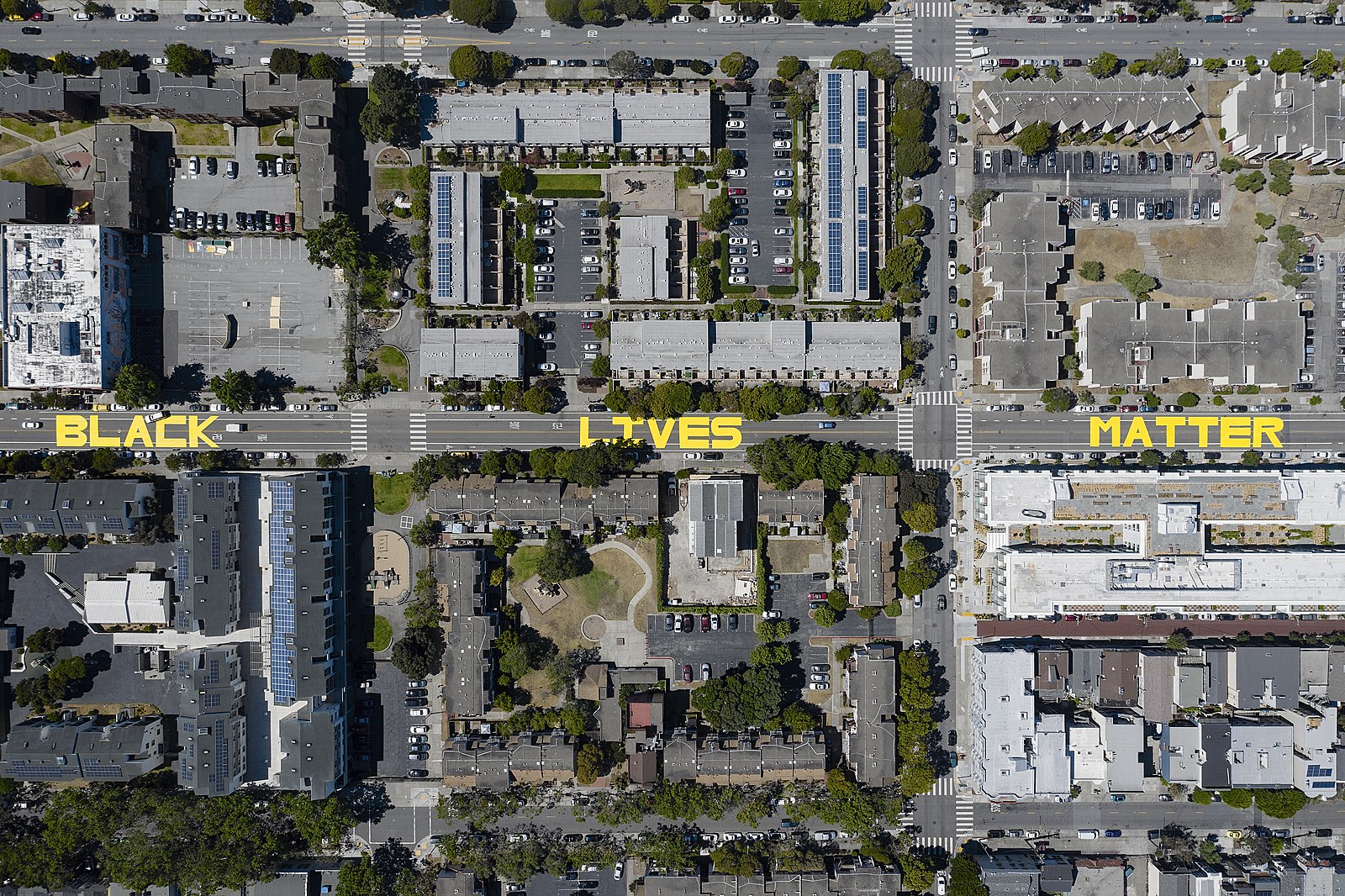
Pic. 14 — Black Lives Matter Mural in San Francisco.
Prima — I think there is definitely something so strong about occupying physical space. And visually seeing bodies come together and taking over a space that otherwise has been presented as something that doesn’t belong to them. Or a space where you are not supposed to be. The painting of Black Lives Matter on the streets mainly happened in Washington, D.C. and in New York. I think in LA the action remained more like mass gathering. What I really enjoy learning through these marches is that different organizations have their own trajectory that they draw across the city to commemorate the fatals shot by the police. For instance, one was going through South Central which is predominantly a Black neighborhood. We walked through the main street and encountered a corner store. The leader of the march told us that the sixteen-year-old son of the store owners had been shot to death by the police. And after that we walked to the office of the mayor where speeches started to happen. I think there is something deeply physical about navigating these spaces and asking for collective memory that maybe aren’t really accessible through general mass information sources. It’s also asking people to be responsible and convey the memory of these places onward. The thing that they do a lot during these protests is asking the protestors to “Say Their Name”—that is an act of saying the names of the victims who passed away. And I think that as a commemorative practice is something very basic but also powerful in invoking the identity or personhood of the people who passed away and also recognizing their lives.
BL — อย่างเรื่องของ Black Lives Matter ในอเมริกา เราเห็นสิ่งที่มันเกิดขึ้นบนท้องถนนลุกลามพอๆ กับที่มันเกิดขึ้นในโลกออนไลน์ เรารู้สึกว่าสิ่งที่มันเกิดขึ้นในพื้นที่จริงมันยิ่งใหญ่มาก หมายถึงในแง่ของการเข้าไปสร้างความวุ่นวายกับพื้นที่ และรูปแบบของการแสดงออก ไม่ว่าจะเป็นการดึงเอาอนุสาวรีย์ลง การทาสีเป็นคำว่า Black Lives Matter บนพื้นถนน และอื่นๆ สำหรับที่ประเทศไทย เราคิดว่าอินเทอร์เน็ตเป็นเครื่องมือสำคัญของการประท้วง อาจเป็นเพราะเป็นการชุมนุมที่นำโดยกลุ่มคนรุ่นใหม่ ผู้ซึ่งมีโซเชียลมีเดียเป็นอาวุธโดยธรรมชาติ สำหรับในสหรัฐอเมริกา เราสนใจในการที่ผู้ชุมนุมบุกรุกพื้นที่สาธารณะ และการที่มันสร้างแรงสั่นสะเทือนในแง่ของสเกลด้วย
รูป 14 — ภาพวาดเป็นคำว่า Black Lives Matter บนพื้นถนนในซานฟรานซิสโก
พรีมา — เราคิดว่ามันมีอะไรบางอย่างที่ค่อนข้างแข็งแรงในการเข้าไปยึดครองพื้นที่จริง การได้เห็นร่างกายของคนมารวมกัน และยึดครองพื้นที่ที่ถูกมองว่าไม่ได้เป็นของพวกเขา หรือพื้นที่ที่พวกคุณไม่ควรจะเข้าไป ภาพวาด Black Lives Matter นั้นเกิดขึ้นบนถนน หลักๆ เลยคือที่วอชิงตัน, ดี. ซี. และนิวยอร์ก เราคิดว่าในแอลเอ การแสดงออกจะอยู่ในรูปแบบการรวมตัวเป็นกลุ่มใหญ่ เรารู้สึกสนุกมากกับการเรียนรู้เกี่ยวกับเหตุการณ์ต่างๆ ผ่านการร่วมเดินขบวนที่จัดขึ้นโดยหลากหลายองค์กรที่มีวิถีของตัวเองในการที่จะรำลึกถึงการยิงประชาชนจนถึงแก่ชีวิตโดยตำรวจ ยกตัวอย่างเช่น มีงานนึงที่เกิดขึ้นทางตอนใต้ที่ซึ่งชุมชนคนผิวสีอาศัยอยู่เป็นหลัก พวกเราเดินผ่านไปยังถนนเส้นหลักและได้พบกับร้านค้าตรงหัวมุม ที่ผู้นำขบวนบอกกับพวกเราว่าเจ้าของร้านร้านนี้เป็นพ่อแม่ของเด็กชายอายุสิบหกปีที่ถูกยิงเสียชีวิตโดยตำรวจ หลังจากนั้นพวกเราเดินทางไปที่สำนักงานของนายกเทศมนตรีเพื่อเริ่มกล่าวสุนทรพจน์ เราคิดว่ามันมีอะไรที่ลึกซึ้งทางกายภาพในการที่เราเดินสำรวจพื้นที่เหล่านี้ และการเรียกร้องให้เกิดความทรงจำร่วม ถึงเหตุการณ์ที่ไม่อาจเข้าถึงได้จากแหล่งข้อมูลทั่วไป มันยังช่วยให้เกิดการเรียกร้องให้ผู้คนมีความรับผิดชอบและนำพาความทรงจำเหล่านี้ไปข้างหน้าด้วยกัน สิ่งที่พวกเขาทำอยู่บ่อยๆ ระหว่างการประท้วงเหล่านี้ที่เรียกว่าการ ‘Say Their Name’ เป็นการแสดงออกโดยกล่าวชื่อของผู้คนที่ตกเป็นเหยื่อที่เสียชีวิตไปแล้ว เราคิดว่าสิ่งนี้ก็คือการรำลึกรูปแบบนึงที่เรียบง่ายมากแต่ก็ทรงพลัง ในการเรียกร้องให้ตระหนักถึงอัตลักษณ์ หรือความเป็นมนุษย์ของผู้คนที่เสียชีวิตไปแล้ว และในการรับรู้ถึงการมีอยู่ของพวกเขา
Graf — I just joined the online premiere of Manuel Correa’s Four Hundred Unquiet Graves on October, 1st which is a part of Monument, a collaboration between e-flux Architecture and Het Nieuwe Instituut. The film follows a group of bereaved relatives in the quest to exhume their loved ones—the Republicans—who were murdered from being against the 1936’s coup d’état in Spain and Francisco Franco’s fascist government that came into power afterwards. There is this one scene at the beginning in which a representative of AFFNA36 (the Association of Firing Squad Victims Families of Navarre) announced the Declaration of Reparation and Personal Recognition at Parlamento de Navarra. The declaration itself is really interesting, and the act of paying tribute to people who were massacred from the state agency is also a great move. Do you think it is possible for this thing to really happen here in Thailand?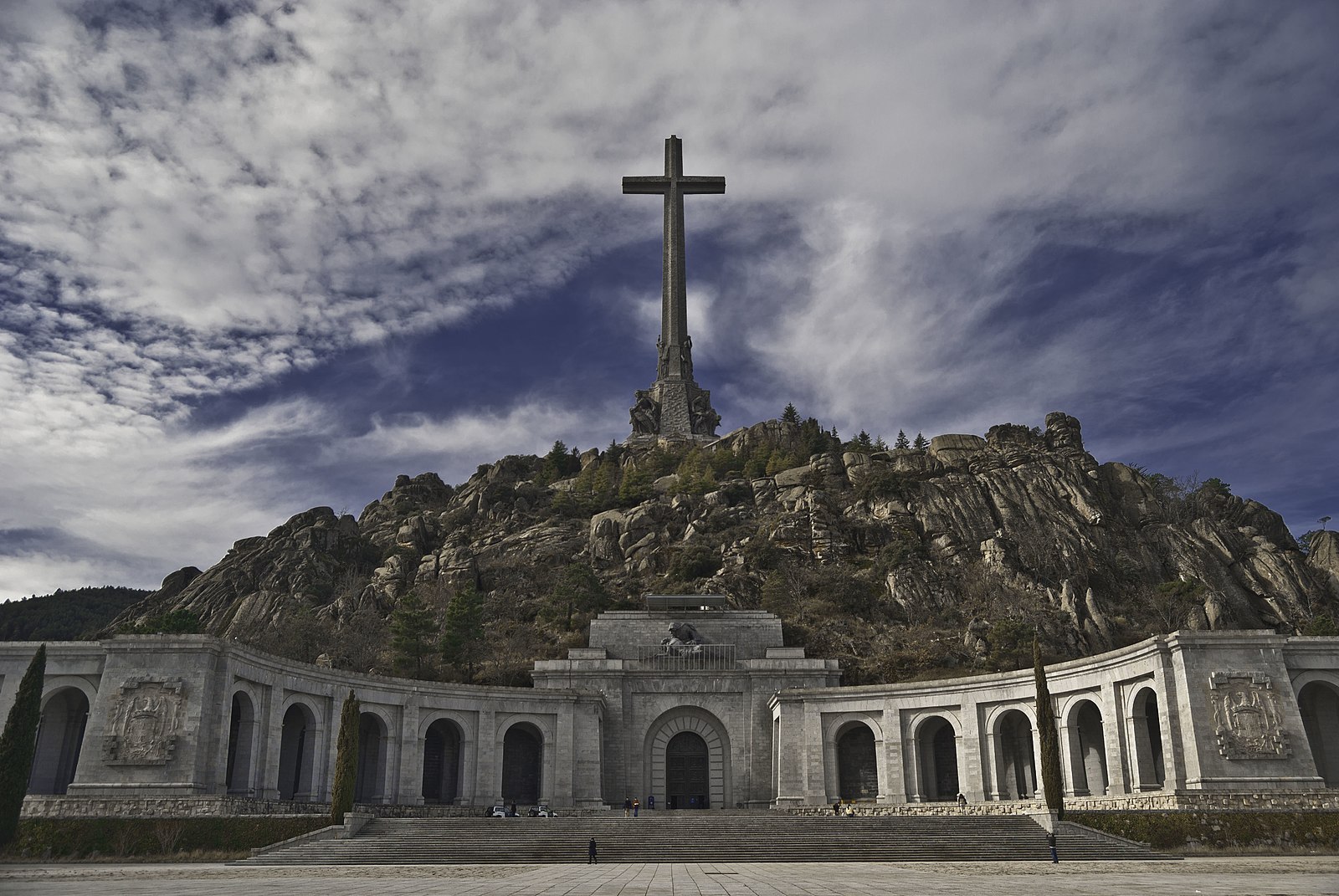
Pic. 15 — El Valle de los Caídos is located sixty kilometers outside of Madrid. The complex was commissioned by Francisco Franco’s fascist government to commemorate the twentieth anniversary of his victory over democracy. It is potentially the largest mass grave in the world, containing 33,800 bodies from 491 graves from all over the Spanish geography. Buried together with the dead fighters of Franco’s army, there are an unknown number of victims of enforced disappearance.
Thanavi — It has not happened yet, that’s why people still commemorate the 6th October Massacre. But it’s the right thing to do. The important step to move forward is you have to admit that you did something wrong to some people. In Thailand, the higher status you are, the more impunity you have. That’s why people are still asking for someone to take responsibility for the 6th October Massacre, to the crackdown on the Red Shirts in 2010.
The 99 Dead performance from the protest last time (September 19, 2020) is very interesting. Using theater is another form of commemoration. It was very touching for me to see one of the volunteer performers, Phayao Akhad, who is the mother of Kamonked Akhad, the nurse who was shot to death in Wat Pathumwanaram, performed with other people. She was wearing a nurse blouse that her daughter had worn that day, and the red thing on that blouse was the real blood. She was different from other performers who wore the white t-shirts, which red powder contained in the bags on the ground would stain as blood when they perform falling. There is this one person with the real blood among others and that was really powerful. I watched the actual performance and also watched the clip. The most touching moment for me is, at one point, when they announced the names of the victims by numbers, and this ‘number 84, Miss Kamonked Akhad’, her mother who was performing her took the bag of the red powder, threw it on her forehead and failed because her daughter was actually shot into the head. How could you do that? It was very cruel and beautiful at the same time. It was painful but she did it. And the impact is nothing can be compared. That is commemoration and that is how art can contribute something.
What I see in the current protest is the making connection to the past. Not just the People’s Party anymore. People also referred to the Red Shirts, Jit Bhumisak, Tiang Sirikhanth, those in exile in Laos, Uncle Nuamthong, and all others. Remembering those who passed away and those who are still alive but wounded have created a bond between people of different generations, different interests, different social classes. They are referred to as those who have fought before us. But what actually binds them together is a political ideology, that is democracy, that they all demand for.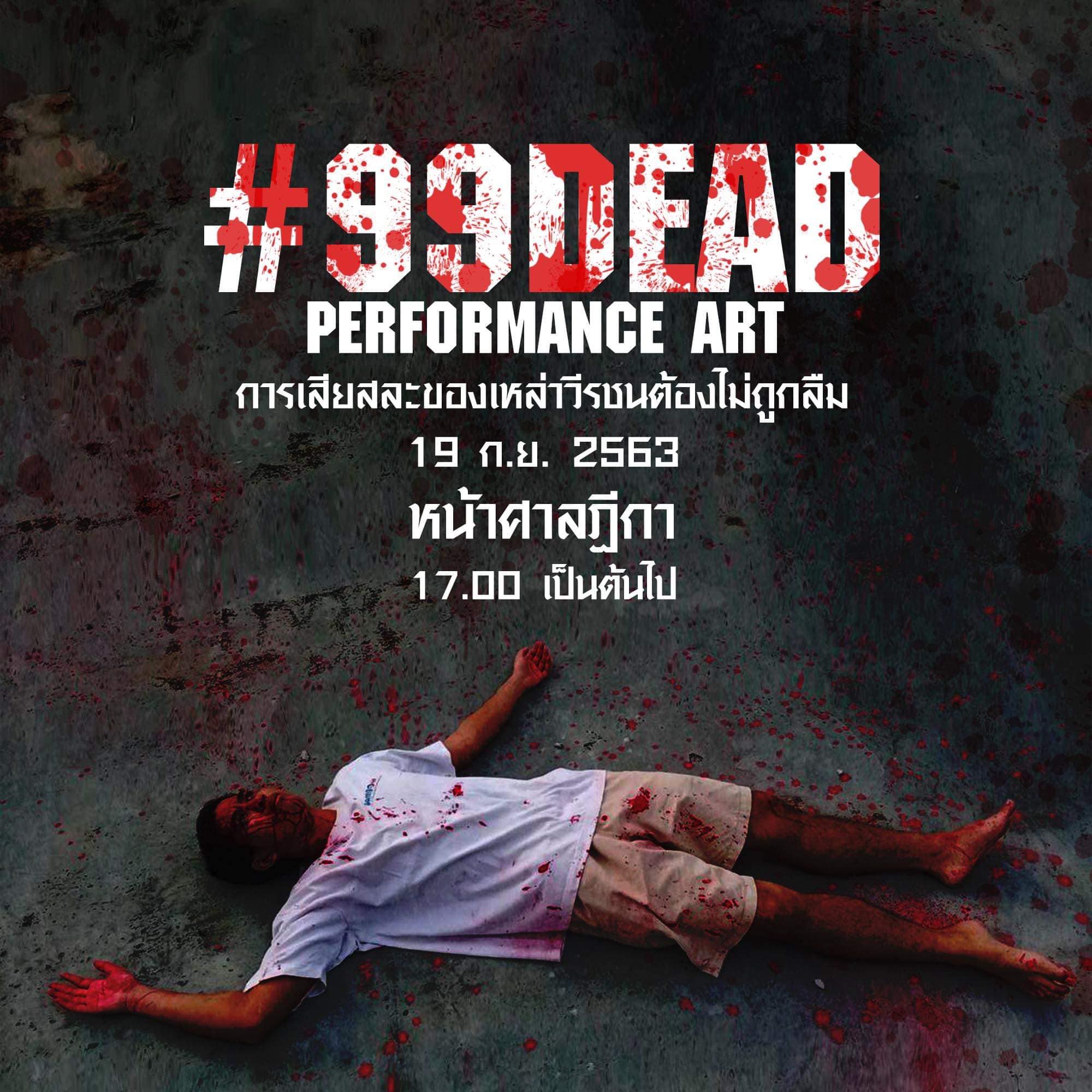
Pic. 16 — 99 Dead performance poster.
กราฟ — เราเพิ่งได้เข้าร่วมชมรอบปฐมทัศน์ออนไลน์ของภาพยนตร์เรื่อง Four Hundred Unquiet Graves ของ มานูแอล คอร์เรีย ไปเมื่อวันที่ 1 ตุลาคม โปรแกรมนี้เป็นส่วนหนึ่งของกิจกรรม Monument ซึ่งเป็นความร่วมมือระหว่าง e-flux Architecture และ Het Nieuwe Instituut ภาพยนตร์เรื่องนี้ติดตามกลุ่มญาติของผู้เสียชีวิตในการเรียกคืนเอาบุคคลอันเป็นที่รักกลับคืนมา ซึ่งก็คือกลุ่มรีพับลิกัน ที่ถูกฆาตกรรมจากการต่อต้านการรัฐประหารที่สเปนในปี 2479 และต่อต้าน ฟรานซิสโก ฟรังโก รัฐบาลฟาสซิสต์ที่ขึ้นมามีอำนาจต่อจากนั้น มีตอนนึงในช่วงเริ่มของภาพยนตร์ที่ตัวแทนของ AFFNA36 (สมาคมกลุ่มครอบครัวหน่วยยิงที่ได้รับผลกระทบในเมื่องนาบาร์รา) ประกาศแถลงการณ์การเยียวยา และการรำลึกถึงแต่ละบุคคล ที่อาคารรัฐสภาเมืองนาบาร์รา (Parlamento de Navarra) คำประกาศนั้นน่าสนใจมาก และท่าทีของผู้คนในการประกอบพิธีสรรเสริญผู้คนที่ถูกสังหารหมู่โดยองค์กรภาครัฐเป็นสิ่งที่สร้างความเปลี่ยนแปลงที่ยิ่งใหญ่มาก คุณคิดว่าสิ่งเหล่านี้จะเกิดขึ้นในประเทศไทยได้มั้ย?
รูป 15 — เอล วาลเล เดอ โลส ไชโดส ตั้งอยู่ห่างออกไปจากเมืองแมดริดหกสิบกิโลเมตร อนุสรณ์ถูกจัดสร้างโดยรัฐบาลฟาสซิสต์ ของ ฟรานซิสโก ฟรังโก เพื่อรำลึกถึงชัยชนะเหนือประชาธิปไตยได้ครบวาระ 20 ปี มีความเป็นไปได้ว่าที่นี่เป็นสุสานที่มีขนาดใหญ่ที่สุดในโลก ที่ฝังร่างกว่า 33.800 ชีวิต จากกว่า 491 หลุมที่มาจากทั่วสเปน ฝังร่วมกันระหว่างกองกำลังของฟรังโกกับเหยื่อที่ถูกบังคับให้สูญหาย
ธนาวิ — มันแค่ยังไม่เกิดขึ้น นั่นคือเหตุผลที่ทำไมผู้คนยังคงรำลึกถึงเหตุการณ์สังหารหมู่ในวันที่ 6 ตุลา แต่มันเป็นสิ่งที่ถูกต้องที่ควรทำ ก้าวสำคัญในการเดินหน้าต่อไปคือการยอมรับว่าคุณได้ทำบางสิ่งที่ผิดพลาดต่อคนบางกลุ่ม ในประเทศไทย ยิ่งคุณมีสถานะสูงมากเท่าไหร่ คุณก็สามารถหลบเลี่ยงความผิดได้มากเท่านั้น นั่นคือสาเหตุว่าทำไมผู้คนยังคงถามหาความรับผิดชอบจากสังหารหมู่จากเหตุการณ์ 6 ตุลา รวมไปถึงการสลายการชุมนุมของกลุ่มคนเสื้อแดงในปี 2553
การแสดงที่ชื่อ 99 Dead ในการประท้วงครั้งก่อนนั้นน่าสนใจมาก การใช้ละครเวทีเป็นรูปแบบนึงของการรำลึก มันทำให้เรารู้สึกประทับใจมากที่ได้เห็นว่าหนึ่งในนักแสดงอาสานั้นคือ พะเยาว์ อัคฮาด ผู้เป็นแม่ของ กมนเกด อัคฮาด นางพยาบาลที่ถูกยิงเสียชีวิตที่วัดปทุมวนาราม ได้มาแสดงร่วมกับคนอื่นๆ เธอสวมชุดนางพยาบาลที่ลูกสาวของเธอสวมใส่ในวันนั้น สีแดงที่ติดอยู่ที่เสื้อนั้นก็เป็นเลือดจริงๆ เธอแตกต่างจากนักแสดงคนอื่นๆ ที่สวมเสื้อยืดสีขาว ที่เมื่อพวกเขาแสดงว่าล้มลง ถุงที่ใส่ผงสีแดงที่พื้นจะแตกกระจายเหมือนกับเลือด การที่มีนักแสดงเพียงคนเดียวที่มีเลือดจริงอยู่ท่ามกลางคนอื่นๆ มันทรงพลังมาก เราได้ดูการแสดงจริงๆ และมาดูย้อนหลังอีกครั้งผ่านคลิปวิดีโอ ช่วงเวลาที่น่าประทับใจที่สุดสำหรับเรา เป็นจุดที่เมื่อมีการประกาศชื่อของเหยื่อไปตามลำดับ จนมาถึง ‘เบอร์ 84 นางสาวกมนเกด อัคฮาด’ แม่ของเธอที่แสดงเป็นตัวเธอก็ได้หยิบถุงที่มีผงสีแดงโยนเข้าใส่หน้าผากของเธอเองและล้มลง เพราะลูกสาวของเธอถูกยิงเข้าที่ศีรษะ เธอทำอย่างนั้นได้ยังไง? มันทั้งโหดร้ายและสวยงามในเวลาเดียวกัน มันน่าเจ็บปวดแต่เธอก็ทำมัน มันมีพลังแบบที่ไม่มีอะไรจะเทียบได้ นั่นคือการรำลึก และคือวิธีที่ศิลปะจะสามารถเข้าร่วมกับสิ่งที่เกิดขึ้น
สิ่งที่เราเห็นจากการประท้วงในปัจจุบันนี้คือการสร้างความเชื่อมโยงกับอดีต ไม่ใช่เพียงแค่กับกลุ่มคณะราษฎรเท่านั้น ผู้คนยังกล่าวถึงกลุ่มคนเสื้อแดง จิตร ภูมิศักดิ์ เตียง ศิริขันธ์ กลุ่มคนที่ลี้ภัยไปที่ลาว ลุงนวมทอง และคนอื่นๆ การจดจำคนที่จากไปแล้ว และคนที่ยังมีชีวิตอยู่แต่บอบช้ำ ได้สร้างสายสัมพันธ์ของผู้คนต่างรุ่น ต่างความสนใจ ต่างสถานะทางสังคม พวกเขาจะถูกรำลึกถึงในฐานะคนที่ต่อสู่เพื่อเรา แต่สายสัมพันธ์ที่แท้จริงที่เชื่อมคนไว้ด้วยกันนั้นคืออุดมการณ์ทางการเมือง ความเป็นประชาธิปไตยคือสิ่งที่ทุกคนเรียกร้อง
Pic. 16 — โปสเตอร์การแสดง 99 Dead
Graf — I have a discussion with the younger generation born after the 2000s when I joined this Internet Universality Beyond Words workshop organized by UNESCO Bangkok two years ago, and there was one argument from them that I found triggered. They said they didn’t know a lot of information as well as history because they couldn’t find it online, and if something didn’t exist in the digital world, they somehow didn’t know its existence in the physical world as well. The data is there all the time, recorded on the internet, but they just didn’t know where or how to access those memories. The point I would like to discuss here is that now the wind has changed direction and it’s very exciting. Digital and media literacy has allowed them to find the stories and truths even more. I think this is one of the key factors that really draws people together to come out and talk about what was happening in the past at this time. And I want to add that a revival of Midnight University, a Thai virtual university for free public education which was shut down after the 2006’s coup d’état, during this period of time is very significant. To me, the Midnight University is both a monument of public intellectualism and a site of commemoration of its lost co-founder and rector, Associate Professor Somkiat Tangnamo.
BL — Talking about Midnight University makes me think of geocities.com, the early hosting website that is currently closed but still archiving the registered information. What appears on the current homepage is ‘A living memorial on early Web culture and an effort to maintain an amazingly extensive collection of information’.
กราฟ — ตอนคุยกับคนรุ่นใหม่ที่เกิดหลังปี 2543 ในเวิร์กชอป Internet Universality Beyond Words ที่จัดขึ้นโดย UNESCO ที่กรุงเทพฯ เมื่อสองปีก่อน มันมีข้อถกเถียงอยู่อันนึงจากพวกเขาที่เรารู้สึกถูกกระตุ้นให้ตระหนัก เขาบอกว่ามีข้อมูลและประวัติศาสตร์อีกจำนวนมากที่พวกเขายังไม่รู้เพราะว่าไม่สามารถค้นหาทางออนไลน์ได้ และถ้าสิ่งนั้นไม่ได้มีอยู่ในโลกดิจิทัล บางครั้งพวกเขาก็ไม่รู้ถึงการมีอยู่ของมันในโลกความเป็นจริงเช่นกัน ข้อมูลมันอยู่ตรงนั้นตลอดเวลา ถูกบันทึกไว้บนอินเทอร์เน็ต แต่พวกเขาไม่รู้ว่าอยู่ที่ไหนและจะเข้าถึงความทรงจำเหล่านั้นยังไง ประเด็นที่เราอยากจะพูดตรงนี้ก็คือลมมันได้เปลี่ยนทิศไปแล้วและมันน่าตื่นเต้นมากๆ การมีสื่อดิจิทัลและการรู้เท่าทันสื่อ เปิดโอกาสให้พวกเขาได้ค้นหาเรื่องและความจริงมากขึ้นกว่าเดิม เราคิดว่านี่เป็นหนึ่งในปัจจัยที่ทำให้คนรวมตัวกันออกมาและพูดถึงสิ่งที่เกิดขึ้นในอดีตกันอยู่ตอนนี้ เราอยากจะเสริมด้วยว่าการกลับมาของ มหาวิทยาลัยเที่ยงคืน มหาวิทยาลัยในโลกเสมือนที่เป็นการศึกษาสาธารณะที่ไม่มีค่าใช้จ่าย ซึ่งถูกปิดตัวลงเมื่อปี 2549 ตอนที่มีรัฐประหาร ช่วงเวลานี้มันสำคัญมาก สำหรับเราแล้ว มหาวิทยาลัยเที่ยงคืนเป็นอนุสาวรีย์สาธารณะของนักคิด และยังเป็นที่ทางให้เกิดการรำลึกถึงการสูญเสียผู้ก่อตั้งและอธิการบดี ผู้ช่วยศาสตราจารย์สมเกียรติ ตั้งนโม
BL — พอพูดถึงเว็บไซต์มหาวิทยาลัยเที่ยงคืน ทำให้นึกถึง geocities.com เว็บโฮสท์ติ้งยุคแรกๆที่ปิดตัวไปแล้วแต่ยังมีการจัดเก็บข้อมูลเว็บไซต์ที่ลงทะเบียนไว้อยู่ แล้วมีเขียนอธิบายบนหน้าเว็บไว้ว่า ‘อนุสรณ์ของวัฒนธรรมเว็บไซต์ยุคแรกที่ยังมีชีวิต’
BL — Founding a museum by collecting objects to exhibit and talk about certain topics could be called a commemoration? How does it work differently to a public commemoration like a monument?
Thanavi — Museums are to make people remember, but we have very few museums that talk about the recent past. We have a lot of museums about the Ayutthaya period and that’s how the state wants us to remember the glorious kingdom in the past. We don’t have a variety of museums here. And the difficult history such as the 6th October Massacre still doesn’t have a museum. There’s a ‘museum project’ about the 6th October Massacre but they don’t have an actual building to house the collection yet. They collect objects, keep them somewhere, and make exhibitions, probably every year, like now they are having it at Thammasat University. Also there is a problem with budget and maintenance, it’s not just about opening a museum, you have to run it but where are the resources?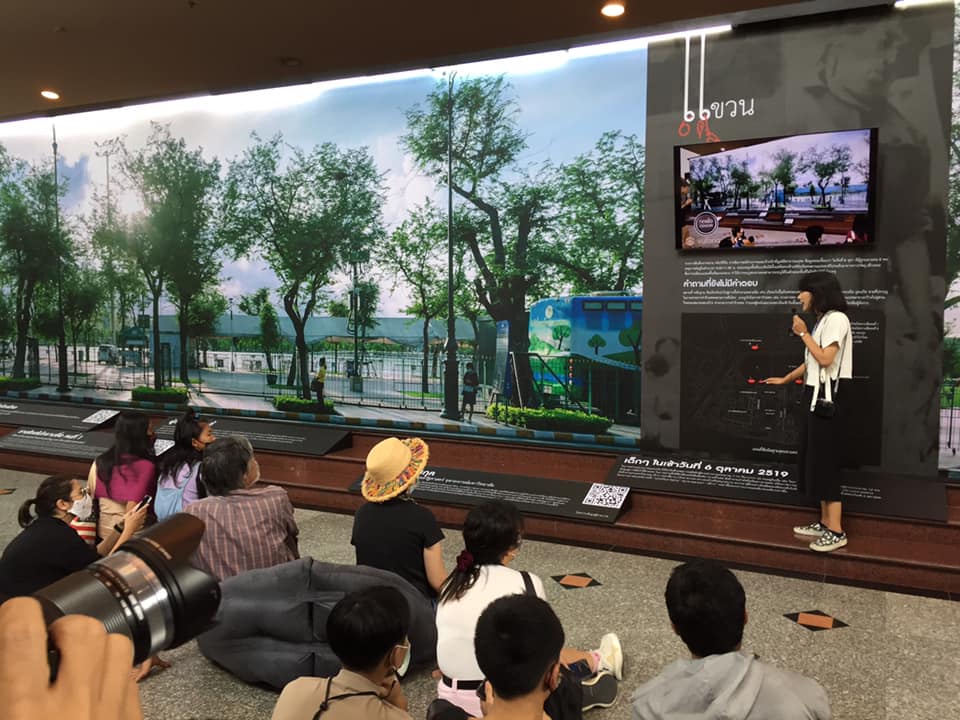
Pic. 17 — แขวน exhibition as part of a ‘museum project’ about the 6th October Massacre. The ‘pop up’ museum has been assembled at the main conference hall at Thammasat University’s Tha Prachan campus from October 1 to 11, 2020.
BL — การทำพิพิธภัณฑ์ โดยการเก็บรวมรวมสิ่งของเพื่อที่จะจัดแสดง และพูดถึงเกี่ยวกับประเด็นบางอย่างนับว่าเป็นการรำลึกมั้ย? มันทำงานต่างจากอนุสาวรีย์ในพื้นที่สาธารณะยังไง?
ธนาวิ — พิพิธภัณฑ์คือการทำให้ผู้คนจดจำ แต่เรามีพิพิธภัณฑ์น้อยมากที่พูดถึงเหตุการณ์ในอดีตอันใกล้ เรามีพิพิธภัณฑ์มากมายที่พูดถึงยุคกรุงศรีอยุธยา และนั่นเป็นสิ่งที่รัฐอยากให้เราจดจำ นั่นก็คือราชอาณาจักรอันรุ่งเรืองในอดีต เราไม่ได้มีพิพิธภัณฑ์ที่หลากหลายที่นี่ และประวัติศาสตร์ที่เป็นเรื่องยากอย่างการสังหารหมู่ 6 ตุลาก็ยังไม่ได้มีพิพิธภัณฑ์ มีแต่ ‘โปรเจกต์ พิพิธภัณฑ์’ เกี่ยวกับการสังหารหมู่ 6 ตุลา แต่พวกเขาก็ไม่ได้มีอาคารจริงๆ ที่เอาไว้เก็บรวบรวมคอลเลกชั่น พวกเขารวบรวมสิ่งของ เก็บไว้ในที่ๆ จะเอามาทำเป็นนิทรรศการ บางทีอาจจะเกิดขึ้นทุกๆ ปี อย่างตอนนี้ก็กำลังมีนิทรรศการนี้ที่มหาวิทยาลัยธรรมศาสตร์ และยังมีปัญหาเรื่องงบประมาณ การบำรุงรักษา มันไม่ใช่แค่การเปิดพิพิธภัณฑ์ แต่รวมไปถึงการดำเนินการอื่นๆ ด้วย แต่เราจะเอาทรัพยากรเหล่านั้นมาจากไหน?
รูป 17 — นิทรรศการ แขวน ภายในโครงการจัดตั้งพิพิธภัณฑ์ 6 ตุลา เปิดให้เข้าชมตลอดเดือนตุลาคม 2563 ห้องโถงหอประชุมใหญ่ ม.ธรรมศาสตร์ ท่าพระจันทร์ วันที่ 1 ถึง 11 ตุลาคม 2563.
BL — The reason that I brought the thing about the museum is that when I researched the idea and the concept of the monument and the act of toppling down the statues like in the US and other countries, I found one of the discussions talking about what we should do with the monument if that is not representing the ideology of the time anymore, should it be toppled down by the people, should it be done by a state, and where it should be placed. Should it be just removed and abandoned or move it to the museum to give a context so people can discuss what is the history of this and that monument or statue. Rather than put it in the public and hurt some people’s feelings.
Thanavi — Removing statues is something that needs so many people to engage with. Any democratic country would have people share their different views and debate. If there are people who want to remove the statue of this person because he is racist, there would also be some other people who also believe that this same person contributed something so greatly to the society so they want to keep it. For example, let’s remove this guy from this plaza but put him in the museum, of course people will still complain why does he have a place in the museum. It needs negotiation and it could be very long but that is a learning for everyone. And that’s a process of growing together in society. If you’re not going to be authoritarian, you need to listen.
BL — สาเหตุที่เรายกประเด็นเรื่องพิพิธภัณฑ์ขึ้นมาเพราะตอนที่ศึกษาเกี่ยวกับแนวคิดและคอนเซปต์ของอนุสาวรีย์และท่าทีของการทำลายอนุสาวรีย์ในสหรัฐอเมริกา และเมืองอื่นๆ เราพบหนึ่งในข้อถกเถียงเกี่ยวกับว่าเราควรจัดการกับอนุสาวรีย์ยังไงถ้ามันไม่ได้เป็นตัวแทนของอุดมการณ์ของยุคสมัยอีกแล้ว มันควรจะถูกเอาลงโดยประชาชนเอง หรือทำโดยรัฐ ที่ไหนที่มันควรจะถูกจัดวาง จริงๆ แล้วควรถูกเอาออกและทิ้งไว้ หรือย้ายมันเข้าไปในพิพิธภัณฑ์เพื่อสร้างบริบทแวดล้อมให้กับมัน เพื่อที่ผู้คนจะได้ศึกษาประวัติศาสตร์ของอนุสาวรีย์หรือรูปปั้นนั้น มากกว่าที่จะเอามันไว้ในพื้นที่สาธารณะและสร้างความรู้สึกไม่ดีกับผู้คน
ธนาวิ — การจะรื้อถอนรูปปั้นเป็นสิ่งที่ต้องการผู้คนหลายฝ่ายมาร่วมตัดสิน ในประเทศที่เป็นประชาธิปไตย อาจจะให้ผู้คนมาแบ่งปันมุมมองที่ต่างกันแล้วถกเถียง ถ้ามีผู้คนที่อยากจะรื้อถอนรูปปั้นของคนคนนึงที่เหยียดเชื้อชาติ ก็จะต้องมีคนบางกลุ่มเชื่อว่าคนคนเดียวกันนี้ก็สร้างประโยชน์ที่มหาศาสให้กับสังคม พวกเขาจึงอยากให้เก็บมันไว้ ยกตัวอย่างเช่น เดี๋ยวเราจะรื้อรูปปั้นชายคนนี้ออกจากลานนี้ แต่จะเอามันไปเก็บไว้ที่พิพิธภัณฑ์ แน่นอนว่าก็จะยังมีคนบางกลุ่มเรียกร้องว่าทำไมต้องมีสถานที่อยู่ให้กับมันในพิพิธภัณฑ์ มันต้องการการต่อรองและมันอาจจะยาวนาน แต่ทุกคนก็ได้เรียนรู้ไปด้วยกัน นั่นคือกระบวนการเติบโตไปด้วยกันในสังคม ถ้าคุณไม่ต้องการที่จะเป็นเผด็จการ คุณก็ต้องรับฟัง
Graf — Compared to the States, there are a lot more museums that really focus on and talk about the people’s history.
Prima — I think in the specific case of the US, the thing that is frustrating for people who want to have these monuments removed is that there is not the same amount of commemorative places for people who are not white colonialists. But I’m also with you Thanavi, on this idea that it’s not about where the monument is placed or whether it’s removed or not but rather a negotiation of the actual history that those things represent and how people in America can come to an agreement of how to move forward together with all these baggages and not erasing one in order to uplift the other. Because it is all part of the history and it’s all part of the same culture and the things that have brought us to the present that we are in. But I think that there is still a lack of recognition of the contribution of immigrants and African Americans to the history of the US. That still needs to be addressed and still needs to materialize in space.
กราฟ — เทียบกับที่สหรัฐอเมริกาแล้ว มันมีพิพิธภัณฑ์ที่มุ่งไปที่การพูดถึงประวัติศาสตร์ของคนทั่วไปมากกว่า
พรีมา — เราคิดว่าในกรณีเฉพาะอย่างในสหรัฐอเมริกา สิ่งที่สร้างความไม่พอใจให้กับผู้คนที่อยากให้รื้อถอนอนุสาวรีย์พวกนี้ลง คือการที่มันไม่มีอนุสรณ์สถานในจำนวนที่พอๆ กัน ให้กับกลุ่มคนที่ไม่ใช่นักล่าอาณานิคมผิวขาว เราเห็นด้วยกับธนาวิในแนวคิดที่ว่ามันไม่เกี่ยวว่าอนุสาวรีย์มันควรถูกตั้งอยู่ที่ไหนหรือถูกรื้อถอนหรือไม่ แต่เกี่ยวกับการต่อรองเพื่อให้ได้มาซึ่งประวัติศาสตร์ที่แท้จริง ที่ซึ่งอนุสาวรีย์นั้นเป็นตัวแทน และเกี่ยวกับว่าผู้คนในอเมริกาจะสามารถตกลงกันยังไงที่จะก้าวไปข้างหน้าด้วยกันกับสัมภาระเหล่านี้โดยไม่เลือกที่จะลบเหตุการณ์บางอย่างเพื่อที่จะเชิดชูอีกอย่าง เพราะทั้งหมดมันก็เป็นส่วนประกอบของประวัติศาสตร์ และมันเป็นส่วนหนึ่งของวัฒนธรรมเดียวกัน เป็นสิ่งที่พาเรามาถึงปัจจุบันที่เราอยู่ตอนนี้ แต่เราคิดว่ามันก็ยังขาดการรับรู้เรื่องการมีส่วนร่วมของผู้อพยพและกลุ่มคนแอฟริกัน อเมริกันในประวัติศาสตร์ของสหรัฐ ซึ่งเป็นสิ่งที่จำเป็นต้องพูดถึงและจำเป็นต้องทำให้เป็นรูปเป็นกายภาพในพื้นที่จริง
Thanavi — Many people know that Pridi Banomyong is not very into the LGBTQ. I’m not surprised with his attitude because he has an idea of his generation. But do we need to remove his statue from Thammasat? or can we change the meaning of the monument? You know, the meaning of the monument is not static. Of course every monument could have original meaning, that’s why people build a monument or a statue. But it doesn’t mean it can not be changed.
Graf — This reminds me of Alois Riegl’s distinction between ‘unintentional monument’ and ‘deliberate monument’ that Margrethe Troensegaard mentioned in her 2016’s essay What’s in a Name? Questions for a New Monument. Let me quote, “An unintentional monument could be the church built by a king in order to prove his power to his contemporaries, without deliberately planning for this to gain the status of a monument for future generations. Or it could even be a scrap of paper that later proves to be of historical importance, thus upgrading its role and value from inert matter to that of testimony or historical witness. The deliberate monument, on the other hand, is produced for the sake of being exactly and only that. In the case of the unintentional monument, it is “we modern viewers, rather than the works themselves by virtue of their original purpose [who] assign meaning and significance to a monument,” whereas in the case of the deliberate monument, the commemorative value is dictated to us by the creator. I think the meaning of the word ‘monument’ or even commemorative object is changeable now.
ธนาวิ — หลายคนรู้ว่าปรีดี พนมยงค์ ไม่ชอบกลุ่ม LGBTQ มากเท่าไหร่ เราไม่แปลกใจกับทัศนคตินี้ของเขาเพราะก็เป็นแนวคิดของคนรุ่นเขา แต่เราจำเป็นต้องรื้อถอนรูปปั้นของเขาออกจากธรรมศาสตร์มั้ย? หรือว่าเราสามารถที่จะเปลี่ยนความหมายของอนุสาวรีย์ได้มั้ย? ความหมายของอนุสาวรีย์มันไม่หยุดอยู่กับที่ แน่นอนว่ามันมีความหมายดั้งเดิมของมัน นั่นคือเหตุผลว่าทำไมผู้คนถึงสร้างอนุสาวรีย์ แต่ก็ไม่ได้หมายความว่ามันเปลี่ยนแปลงไมไ่ด้
กราฟ — มันทำให้เรานึกถึงสิ่งที่อโลอิส รีเกล พูดถึงเรื่องความแตกต่างระหว่าง ‘อนุสาวรีย์ที่เกิดโดยไม่ตั้งใจ (unintentional monument)’ กับ ‘อนุสาวรีย์โดยเจตนา (deliberate monument)’ ที่มาเกร โทรนซีกอด อ้างถึงในบทความของเธอเมื่อปี 2559 ที่ชื่อ What’s in a Name? Questions for a New Monument ตรงที่เธอบอกว่า “อนุสาวรีย์ที่เกิดโดยไม่ตั้งใจอาจจะเป็นโบสถ์ที่สร้างโดยกษัตริย์เพื่อที่จะพิสูจน์ถึงอำนาจของเขาต่อฝูงชน โดยไม่ได้มีการไตร่ตรองวางแผนเพื่อที่จะได้มาซึ่งสถานะของการเป็นอนุสาวรีย์ให้คนรุ่นหลัง หรือมันอาจจะเป็นเพียงแค่กระดาษใบหนึ่งที่ภายหลังได้รับการพิสูจน์ว่ามีความสำคัญทางประวัติศาสตร์ มันจึงได้รับการเลื่อนขั้นและให้ค่าจากการเป็นเพียงสิ่งของชิ้นหนึ่งสู่การเป็นหลักฐานหรือพยานทางประวัติศาสตร์ ในทางกลับกันอนุสาวรีย์ที่ผ่านการไตร่ตรองมาให้สร้างถูกผลิตขึ้นเพื่อจุดประสงค์ในการเป็นอนุสาวรีย์เพียงอย่างเดียว ในกรณีของอนุสาวรีย์ที่เป็นโดยไม่ได้ตั้งใจ “พวกเราที่เป็นผู้ชมจากยุคสมัยใหม่ เป็นผู้ให้ความหมาย และความสำคัญกับอนุสาวรีย์นั้นมากกว่าคุณค่าที่มาจากตัวมันเอง” ในกรณีของอนุสาวรีย์ที่ถูกสร้างโดยเจตนา คุณค่าของการรำลึกนั้นถูกบงการโดยผู้สร้าง” เราคิดว่าความหมายของคำว่า อนุสาวรีย์ หรือแม้กระทั่งวัตถุเพื่อการรำลึกได้เปลี่ยนไปแล้วในตอนนี้
Thanavi — I think erecting monuments is a very masculine thing. Most Thai monuments contain images of men, warriors or the commoners who were the warriors fighting the Burmese, the communists, etc. Especially war monuments or wars figures are very masculine, and very macho. It’s typical to use the word ‘erecting’ for the monument, but I was also thinking about the connotation of something erected. And in erecting monuments as part of war propaganda, you must show strength and masculinity. That’s why all of them are very figurative. But I think to do memorial practice online, it decreases that sense of super masculinity. I don’t have any proof of that but that’s my feeling. To me, it’s more opened, expanded, and inclusive.
Prima — Just the material and financial cost of erecting monuments alone come from places that already have those resources so it’s gonna rarely be coming from the people or groups that are underrepresented. But I don’t think we need more monuments (laughter). It’s nice to have the online world that is constantly being built by multiple actors and that memes or images that would get cropped, used, utilised, reappropriated by different people and that’s how memory lives on. And maybe it is closer to how memory functions in connection with life. Some memories might surface up in a moment rather than the other because it is relevant to the present now. I’m kind of “yes!” for dematerialization of these structures of power or vehicles of power.
ธนาวิ — เราคิดว่าการจัดตั้งอนุสาวรีย์เป็นอะไรที่มีความเป็นชายมาก อนุสาวรีย์ส่วนใหญ่ในไทยถูกสร้างเป็นภาพของผู้ชาย นักรบ หรือชาวบ้านผู้ซึ่งออกรบกับพม่า กลุ่มคอมมิวนิสต์ เป็นต้น โดยเฉพาะอนุสาวรีย์เกี่ยวกับสงคราม หรือรูปปั้นเกี่ยวกับสงครามก็จะมีความเป็นผู้ชายมาก และแข็งแรงมาก เป็นปกติที่เราจะใช้คำว่า ‘ตั้ง’ (erect) กับอนุสาวรีย์ แต่เราก็คิดถึงเกี่ยวกับความหมายโดยนัยของมันว่าคือบางสิ่งที่ตั้งขึ้นด้วย ในการจัดตั้งอนุสาวรีย์ในฐานะเป็นส่วนหนึ่งของการโฆษณาชวนเชื่อเรื่องสงคราม คุณต้องแสดงออกถึงความเข้มแข็งและความเป็นชาย นั่นคือเหตุผลที่ว่าทำไมต้องทำเป็นรูปคน แต่เราคิดว่าการทำอนุสรณ์สถานบนโลกออนไลน์ได้ลดแนวคิดของความเป็นชายลงไปมาก เราไม่ได้มีข้อพิสูจน์ในเรื่องนี้ แต่เป็นความรู้สึก สำหรับเรามันเปิดกว้างขึ้น มีขอบเขตกว้างขึ้น และเป็นอะไรก็ได้มากขึ้น
พรีมา — แค่เรื่องของวัสดุและค่าใช้จ่ายในการตั้ง อนุสาวรีย์เพียงอย่างเดียวก็ต้องมาจากที่ๆ มีทรัพยากรอยู่แล้ว จึงเป็นไปได้ยากที่มันจะมาจากประชาชนหรือคนกลุ่มที่ไม่ได้รับการพูดถึง แต่เราไม่คิดว่าพวกเราต้องการอนุสาวรีย์เพิ่มแล้วนะ (หัวเราะ) มันก็ดีที่จะถูกสร้างอยู่ในโลกออนไลน์ จะได้มีคนจากหลายหลายร่วมกันสร้าง พวกมีม หรือภาพที่จะถูกนำไปตัดต่อ ใช้งาน สร้างประโยชน์ ให้ความหมายใหม่โดยผู้คนที่หลากหลาย มันคือการทำให้ความทรงจำคงอยู่ และบางทีมันใกล้ชิดกับการที่ความทรงจำทำงานเกี่ยวเนื่องกับชีวิต บางความทรงจำอาจลอยเหนือกว่าอีกความทรงจำในบางสถานการณ์เพราะมันเกี่ยวโยงกับปัจจุบันขณะ “ใช่!” เราสนับสนุนให้โครงสร้างอำนาจหรือสิ่งที่ใช้ขับเคลื่อนอำนาจที่มาจากการสร้างอนุสาวรีย์มันหมดไปเสียที
Thanavi — There is the debate going on whether to build the statue of Jit Bhumisak at Chulalongkorn University or not. There are statues of King Rama V and King Rama VI and people start thinking why not a statue of Jit Bhumisak. To see it as a political act is understandable; there are statues of the monarchs so why not a statue of the commoner who contributed so much? But this whole idea of making another statue, is it necessary? Do you really need it, or are there any other ways to remember him, commemorate him, respecting him?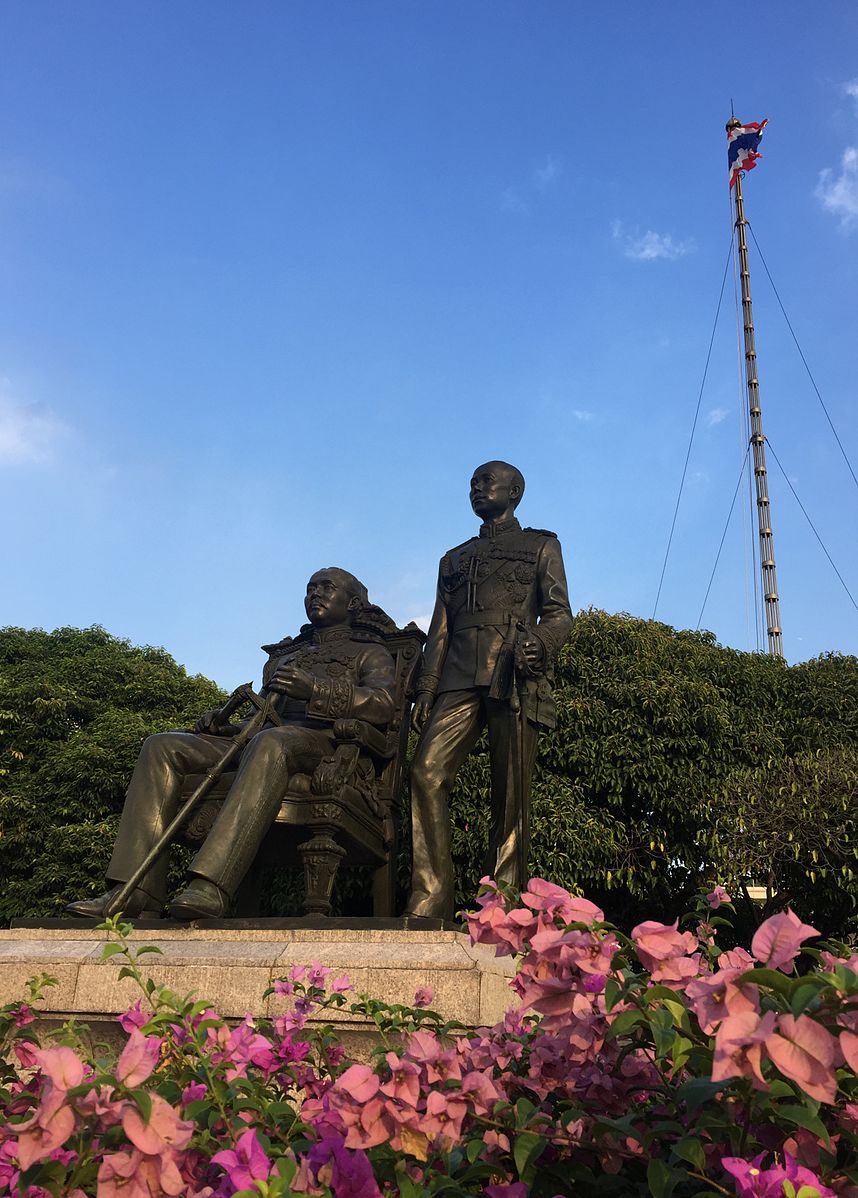
Pic. 18 — The Royal Monument of King Chulalongkorn and King Vajiravudh were built in 1987, on the occasion of the 70th anniversary of Chulalongkorn University establishment. The statues of both monarchs were placed in front of the University’s Main Auditorium.
Pic. 19 — Jit Bhumisak was a Thai author, philologist, historian, poet, songwriter, and Marxism thinker. His most influential book was The Face of Thai Feudalism, written in 1957 under the pseudonym Somsamai Srisootarapan. A student group from Chulalongkorn University were calling for a statue of Jit Bhumisak on the 90th anniversary of his birth in September (there is Jit Bhumisak’s statue located at Ban Nong Kung, Kam Bo, Varishbhum, in Sakon Nakhon). Chit’s statue would not only commemorate his memory but serve as a point of solidarity between those struggling for democracy against continued military interference into politics. The statue would also commemorate other activists and dissidents who were disappeared by the Thai state, most notably Wanchalearm Satsakit who was abducted from his apartment in Cambodia in June.
BL — Instead of spending more on monuments, it’s better to find other ways.
ธนาวิ — มันมีข้อถกเถียงเกิดขึ้นว่าจะสร้างรูปปั้นของ จิตร ภูมิศักดิ์ ที่จุฬาฯ มั้ย ที่นั่นมีรูปปั้นของรัชกาลที่ห้า และรัชกาลที่หกอยู่ และผู้คนเริ่มคิดว่าทำไมจะมีรูปปั้นของจิตร ภูมิศักดิ์ไม่ได้ ถ้ามองมันเป็นการกระทำเชิงการเมืองก็เข้าใจได้ ถ้ามีรูปปั้นของราชวงศ์ได้ ทำไมถึงไม่มีของชาวบ้านผู้ที่ทำประโยช์หลายอย่าง? แต่ในภาพรวมแล้ว การสร้างอนุสาวรีย์ขึ้นมาอีกนั้นจริงๆ แล้วจำเป็นมั้ย? เรายังต้องการมันอีกจริงๆ หรือมันมีทางอื่นที่จะจดจำเขา รำลึกถึงเขา และเคารพเขา?
Pic. 18 — พระบรมราชานุสาวรีย์ของพระบาทสมเด็จพระจุลจอมเกล้าเจ้าอยู่หัว และพระบาทสมเด็จพระมงกุฎเกล้าเจ้าอยู่หัว ถูกสร้างขึ้นในปี 2530 เนื่องในโอกาสก่อตั้งจุฬาลงกรณ์มหาวิทยาลัยครบ 70 ปี ประดิษฐานอยู่ด้านหน้าหอประชุมจุฬาลงกรณ์มหาวิทยาลัย
รูป 19 — จิตร ภูมิศักดิ์ เป็นนักเขียน นักปรัชญา นักประวัติศาสตร์ กวี นักแต่งเพลง และนักคิดสายมาร์กซิสม์ หนังสือที่ทรงอิทธิพลที่สุดที่เขาเขียนมีชื่อว่า โฉมหน้าศักดินาไทย เขียนขึ้นในปี 2500 ภายใต้นามแฝง สมสมัย ศรีศูทรพรรณ กลุ่มนักศึกษาจากจุฬาลงกรณ์มหาวิทยาลัยได้เคยเรียกร้องให้มีการจัดตั้งรูปปั้นของ จิตร ภูมิศักดิ์ เนื่องในโอกาสครบรอบวันเกิด 90 ปีของเขาในเดือนกันยายนที่ผ่านมา (ทั้งนี้ มีอนุสาวรีย์จิตร ภูมิศักดิ์ตั้งอยู่ที่บริเวณที่เขาเสียชีวิต ณ บ้านหนองกุง ตำบลคำบ่อ อำเภอวาริชภูมิ จังหวัดสกลนคร) รูปปั้นของจิตรจะไม่เพียงเป็นอนุสรณ์ความทรงจำของเขา แต่ยังเป็นจุดรองรับความเป็นน้ำหนึ่งใจเดียวกันระหว่างผู้ที่ต่อสู้เพื่อประชาธิปไตยโดยการต่อต้านการแทรกแซงทางการเมืองของทหาร รูปปั้นนี้อาจเป็นอนุสรณ์แก่นักเคลื่อนไหวและผู้ที่คัดค้านการอุ้มหายโดยรัฐไทย อย่างในกรณีอันโด่งดังของวันเฉลิม สัตย์ศักดิ์สิทธิ์ ที่ถูกลักพาตัวไปจากอพาร์ทเมนท์ในกัมพูชาเมื่อเดือนมิถุนายน
BL — แทนที่จะต้องจ่ายเงินไปกับอนุสาวรีย์ น่าจะดีกว่าถ้าจะหาวิธีอื่น
Prima — Yeah. Maybe demolishing them all is better. Reuse the metal for something else.
Thanavi — Or making a commemoration in another form. Even better to build schools in the name of this and that.
พรีมา — ใช่เลย ทำลายมันไปให้หมดน่าจะดีกว่า แล้วนำโลหะพวกนั้นไปใช้ประโยชน์อย่างอื่นแทน
ธนาวิ — หรือการสร้างการรำลึกในรูปแบบอื่น เช่น อาจจะดีกว่าก็ได้ถ้าจะสร้างโรงเรียนในนามของบุคคลใดบุคคลหนึ่งแทน
Paphop Kerdsup (Graf) is a writer and editor. Trained as an architect, his practice, however, revolves around other forms of architectural production be it writing, storytelling, or talking. His interest engages with a variety of media as a means of ‘reading’ architecture and the built environment.
Thanavi Chotpradit (Thanavi) is a lecturer in modern and contemporary Thai art history in the Department of Art History, Faculty of Archaeology, at Silpakorn University, Bangkok, Thailand, an independent curator and a member of the editorial collective of Southeast of Now: Directions in Contemporary and Modern Art in Asia. Her areas of interest include modern and Thai contemporary art in relation to memory studies, war commemoration, Thai politics and archival practices.
Prima Jalichandra-Sakuntabhai (Prima) is a transdisciplinary artist, working across performance, video and installation. Currently based in LA, Prima’s work addresses the structures of euro-centric masculine power in space and architecture, and their domination over the shaping of other identities. Through performative lectures and site-specific installations, they take apart the physical and structural tools of the Western academic, underlining the fictional nature of Western rationality and the way hegemony legitimizes certain truths over others.
https://www.primasakuntabhai.com
ปภพ เกิดทรัพย์ (กราฟ) เป็นนักเขียนและบรรณาธิการ แม้ได้รับการฝึกฝนเพื่อเป็นสถาปนิก แต่การทำงานของเขามักโคจรอยู่โดยรอบรูปแบบอื่นๆ ของการผลิตสร้างทางสถาปัตยกรรม อาทิ การเขียน การเล่าเรื่อง หรือการพูดคุย ความสนใจของเขาข้องเกี่ยวกับการพยายามจัดการและทำความเข้าใจสื่อหลากรูปแบบในฐานะหนทาง/เครื่องมือสำหรับ ‘อ่าน’ สถาปัตยกรรมและสิ่งแวดล้อมสรรสร้าง
ธนาวิ โชติประดิษฐ (ธนาวิ) อาจารย์สอนเกี่ยวกับศิลปะสมัยใหม่และศิลปะร่วมสมัยในประเทศไทยในภาควิชาประวัติศาสตร์ศิลปะ คณะโบราณคดี มหาวิทยาลัยศิลปากร ภัณฑารักษ์อิสระ และทีมบรรณาธิการวารสารวิชาการเกี่ยวกับศิลปะสมัยใหม่และร่วมสมัยในเอเชียตะวันออกเฉียงใต้ Southeast of Now: Directions in Contemporary and Modern Art in Asia ขอบเขตความสนใจของธนาวิครอบคลุมความสัมพันธ์ระหว่างศิลปะสมัยใหม่และร่วมสมัยในประเทศไทยกับความทรงจำศึกษา พิธีกรรมรำลึกเกี่ยวกับสงครามและการเมืองไทย
พรีมา ชาลีจันทร์ ศกุนตาภัย (พรีมา) เป็นศิลปินที่ทำงานศิลปะหลากหลายแขนง ข้ามระหว่างศาสตร์การแสดง วิดีโอ และศิลปะจัดวาง ปัจจุบันพำนักอยู่ที่แอลเอ ผลงานของพรีมาพูดถึงโครงสร้างแบบยุโรปเป็นศูนย์กลาง ที่มีพลังของความเป็นชายอยู่ในสถาปัตยกรรมและพื้นที่ และความโดดเด่นของโครงสร้างนั้นที่เหนือกว่าการสร้างอัตลักษณ์ของที่อื่น การจัดแสดงบรรยาย และศิลปะจัดวางในพื้นที่ ได้แยกกายภาพและเครื่องมือเชิงโครงสร้างของนักวิชาการตะวันตกออกจากกัน เพื่อเน้นย้ำความมีเหตุผลแบบตะวันตกที่เป็นเพียงเรื่องแต่งโดยธรรมชาติ และการใช้อิทธิพลที่เหนือกว่าในการทำให้ความจริงบางอย่างชอบธรรมกว่าสิ่งอื่น
https://www.primasakuntabhai.com
Cover illustration by Napisa Leelasuphapong, recorded from her commemorative places virtual tour via Google Maps.
ภาพปก โดย นภิษา ลีละศุภพงษ์ บันทึกผ่านกูเกิลแมพจากการเยี่ยมชมอนุสรณ์สถานผ่านโลกเสมือน
Proofread by Supamas Phahulo, Kantida Busaba, Nuttha Isaraphithakkul, Napisa Leelasuphapong
ถอดความเป็นภาษาไทยโดย นภิษา ลีละศุภพงษ์
พิสูจน์อักษรโดย ศุภมาศ พะหุโล, กานต์ธิดา บุษบา, ณัฐา อิสระพิทักษ์กุล, นภิษา ลีละศุภพงษ์